

How to Write an Effective Speech Outline: A Step-by-Step Guide
- The Speaker Lab
- March 8, 2024
Table of Contents
Mastering the art of speaking starts with crafting a stellar speech outline. A well-structured outline not only clarifies your message but also keeps your audience locked in.
In this article, you’ll learn how to mold outlines for various speech types, weaving in research that resonates and transitions that keep listeners on track. We’ll also show you ways to spotlight crucial points and manage the clock so every second counts. When it’s time for final prep, we’ve got smart tips for fine-tuning your work before stepping into the spotlight.
Understanding the Structure of a Speech Outline
An effective speech outline is like a map for your journey as a speaker, guiding you from start to finish. Think of it as the blueprint that gives shape to your message and ensures you hit all the right notes along the way.
Tailoring Your Outline for Different Speech Types
Different speeches have different goals: some aim to persuade, others inform or celebrate. Each type demands its own structure in an outline. For instance, a persuasive speech might highlight compelling evidence while an informative one focuses on clear explanations. Crafting your outline with precision means adapting it to fit these distinct objectives.
Incorporating Research and Supporting Data
Your credibility hinges on solid research and data that back up your claims. When writing your outline, mark the places where you’ll incorporate certain pieces of research or data. Every stat you choose should serve a purpose in supporting your narrative arc. And remember to balance others’ research with your own unique insights. After all, you want your work to stand out, not sound like someone else’s.
The Role of Transitions in Speech Flow
Slick transitions are what turn choppy ideas into smooth storytelling—think about how bridges connect disparate land masses seamlessly. They’re not just filler; they carry listeners from one thought to another while maintaining momentum.
Incorporate transitions that feel natural yet keep people hooked. To keep things smooth, outline these transitions ahead of time so nothing feels left up to chance during delivery.
Techniques for Emphasizing Key Points in Your Outline
To make certain points pop off the page—and stage—you’ll need strategies beyond bolding text or speaking louder. Use repetition wisely or pause strategically after delivering something significant. Rather than go impromptu, plan out what points you want to emphasize before you hit the stage.
Timing Your Speech Through Your Outline
A watchful eye on timing ensures you don’t overstay—or undercut—your moment under the spotlight. The rhythm set by pacing can be pre-determined through practice runs timed against sections marked clearly in outlines. Practice will help ensure that your grand finale isn’t cut short by surprise.
What Type Of Speaker Are You?
Click below to discover your Speaker Archetype and how to start getting booked and paid to speak!
Depending on the type of speech you’re giving, your speech outline will vary. The key ingredients—introduction, body, and conclusion—are always there, but nuances like tone or message will change with each speaking occasion.
Persuasive Speeches: Convincing With Clarity
When outlining a persuasive speech, arrange your arguments from strong to strongest. The primacy effect works wonders here, so make sure to start off with a strong point. And just when they think they’ve heard it all, hit them with an emotional story that clinches the deal.
You might start by sharing startling statistics about plastic pollution before pivoting to how individuals can make a difference. Back this up with data on successful recycling programs which demonstrate tangible impact, a technique that turns facts into fuel for action.
Informative Speeches: Educating Without Overwhelming
An informative speech shouldn’t feel like drinking from a fire hose of facts and figures. Instead, lay out clear subtopics in your outline and tie them together with succinct explanations—not unlike stepping stones across a stream of knowledge.
If you’re talking about breakthroughs in renewable energy technology, use bullet points to highlight different innovations then expand upon their potential implications one at a time so the audience can follow along without getting lost in technical jargon or complexity.
Ceremonial Speeches: Creating Moments That Matter
In a ceremonial speech you want to capture emotion. Accordingly, your outline should feature personal anecdotes and quotes that resonate on an emotional level. However, make sure to maintain brevity because sometimes less really is more when celebrating milestones or honoring achievements.
Instead of just going through a hero’s whole life story, share the powerful tales of how they stepped up in tough times. This approach hits home for listeners, letting them feel the impact these heroes have had on their communities and sparking an emotional bond.
Incorporating Research in Your Speech Outline
When you’re crafting a speech, the backbone of your credibility lies in solid research and data. But remember, it’s not just about piling on the facts. It’s how you weave them into your narrative that makes listeners sit up and take notice.
Selecting Credible Sources
Finding trustworthy sources is like going on a treasure hunt where not all that glitters is gold. To strike real gold, aim for academic journals or publications known for their rigorous standards. Google Scholar or industry-specific databases are great places to start your search. Be picky. Your audience can tell when you’ve done your homework versus when you’ve settled for less-than-stellar intel.
You want to arm yourself with evidence so compelling that even skeptics start nodding along. A well-chosen statistic from a reputable study does more than decorate your point—it gives it an ironclad suit of armor.
Organizing Information Effectively
Your outline isn’t just a roadmap; think of it as scaffolding that holds up your argument piece by piece. Start strong with an eye-opening factoid to hook your audience right off the bat because first impressions matter—even in speeches.
To keep things digestible, group related ideas together under clear subheadings within your outline. Stick to presenting data that backs up each key idea without wandering down tangential paths. That way, everyone stays on track.
Making Data Relatable
Sure, numbers don’t lie but they can be hard to connect to. If you plan on using stats in your speech, make them meaningful by connecting them to relatable scenarios or outcomes people care about deeply. For instance, if you’re talking health statistics, relate them back to someone’s loved ones or local hospitals. By making the personal connection for your audience, you’ll get their attention.
The trick is using these nuggets strategically throughout your talk, not dumping them all at once but rather placing each one carefully where its impact will be greatest.
Imagine your speech as a road trip. Without smooth roads and clear signs, the journey gets bumpy, and passengers might miss the scenery along the way. That’s where transitions come in. They’re like your speech’s traffic signals guiding listeners from one point to another.
Crafting Seamless Bridges Between Ideas
Transitions are more than just linguistic filler. They’re strategic connectors that carry an audience smoothly through your narrative. Start by using phrases like “on top of this” or “let’s consider,” which help you pivot naturally between points without losing momentum.
To weave these seamlessly into your outline, map out each major turn beforehand to ensure no idea is left stranded on a tangent.
Making Use of Transitional Phrases Wisely
Be cautious: overusing transitional phrases can clutter up your speech faster than rush hour traffic. Striking a balance is key—think about how often you’d want to see signposts on a highway. Enough to keep you confident but not so many that it feels overwhelming.
Pick pivotal moments for transitions when shifting gears from one major topic to another or introducing contrasting information. A little direction at critical junctures keeps everyone onboard and attentive.
Leveraging Pauses as Transition Tools
Sometimes silence speaks louder than words, and pauses are powerful tools for transitioning thoughts. A well-timed pause lets ideas resonate and gives audiences time to digest complex information before moving forward again.
This approach also allows speakers some breathing room themselves—the chance to regroup mentally before diving into their next point with renewed vigor.
Connecting Emotional Threads Throughout Your Speech
Last but not least, don’t forget emotional continuity, that intangible thread pulling heartstrings from start-to-finish. Even if topics shift drastically, maintaining an underlying emotional connection ensures everything flows together cohesively within the larger tapestry of your message.
Techniques for Emphasizing Key Points in Your Speech Outline
When you’re crafting your speech outline, shine a spotlight on what matters most so that your audience doesn’t miss your key points.
Bold and Italicize for Impact
You wouldn’t whisper your punchline in a crowded room. Similarly, why let your main ideas get lost in a sea of text? Use bold or italics to give those lines extra weight. This visual cue signals importance, so when you glance at your notes during delivery, you’ll know to emphasize those main ideas.
Analogies That Stick
A good analogy is like super glue—it makes anything stick. Weave them into your outline and watch as complex concepts become crystal clear. But remember: choose analogies that resonate with your target audience’s experiences or interests. The closer home it hits, the longer it lingers.
The Power of Repetition
If something’s important say it again. And maybe even once more after that—with flair. Repetition can feel redundant on paper, but audiences often need to hear critical messages several times before they take root.
Keep these strategies in mind when you’re ready to dive into your outline. You’ll transform those core ideas into memorable insights before you know it.
Picture this: you’re delivering a speech, and just as you’re about to reach the end, your time’s up. Ouch! Let’s make sure that never happens. Crafting an outline is not only about what to say but also how long to say it.
Finding Balance in Section Lengths
An outline isn’t just bullet points; it’s a roadmap for pacing. When outlining your speech, make sure to decide how much time you’d like to give each of your main points. You might even consider setting specific timers during rehearsals to get a real feel for each part’s duration. Generally speaking, you should allot a fairly equal amount of time for each to keep things balanced.
The Magic of Mini Milestones
To stay on track, a savvy speaker will mark time stamps or “mini milestones” on their outline. These time stamps give the speaker an idea of where should be in their speech by the time, say, 15 minutes has passed. If by checkpoint three you should be 15 minutes deep and instead you’re hitting 20 minutes, it’s time to pick up the pace or trim some fat from earlier sections. This approach helps you stay on track without having to glance at the clock after every sentence.
Utilizing Visual Aids and Multimedia in Your Outline
Pictures speak louder than words, especially when you’re on stage. Think about it: How many times have you sat through a presentation that felt like an eternity of endless bullet points? Now imagine if instead, there was a vibrant image or a short video clip to break up the monotony—it’s game-changing. That’s why integrating visual aids and multimedia into your speech outline isn’t just smart. It’s crucial for keeping your audience locked in.
Choosing Effective Visuals
Selecting the right visuals is not about flooding your slides with random images but finding those that truly amplify your message. Say you’re talking about climate change. In this case, a graph showing rising global temperatures can hit hard and illustrate your chosen statistic clearly. Remember, simplicity reigns supreme; one powerful image will always trump a cluttered collage.
Multimedia Magic
Videos are another ace up your sleeve. They can deliver testimonials more powerfully than quotes or transport viewers to places mere descriptions cannot reach. But be warned—timing is everything. Keep clips short and sweet because no one came to watch a movie—they came to hear you . You might highlight innovations using short video snippets, ensuring these moments serve as compelling punctuations rather than pauses in your narrative.
The Power of Sound
We often forget audio when we think multimedia, yet sound can evoke emotions and set tones subtly yet effectively. Think striking chords for dramatic effect or nature sounds for storytelling depth during environmental talks.
Audiences crave experiences they’ll remember long after they leave their seats. With well-chosen visuals and gripping multimedia elements woven thoughtfully into every section of your speech outline, you’ll give them exactly that.
Rehearsing with Your Speech Outline
When you’re gearing up to take the stage, your speech outline is a great tool to practice with. With a little preparation, you’ll give a performance that feels both natural and engaging.
Familiarizing Yourself with Content
To start off strong, get cozy with your outline’s content. Read through your outline aloud multiple times until the flow of words feels smooth. This will help make sure that when showtime comes around, you can deliver those lines without tripping over tough transitions or complex concepts.
Beyond mere memorization, understanding the heart behind each point allows you to speak from a place of confidence. You know this stuff—you wrote it. Now let’s bring that knowledge front and center in an authentic way.
Mimicking Presentation Conditions
Rehearsing under conditions similar to those expected during the actual presentation pays off big time. Are you going to stand or roam about? Will there be a podium? Think about these details and simulate them during rehearsal because comfort breeds confidence—and we’re all about boosting confidence.
If technology plays its part in your talk, don’t leave them out of rehearsals either. The last thing anyone needs is tech trouble during their talk.
Perfecting Pace Through Practice
Pacing matters big time when speaking. Use timed rehearsals to nail down timing. Adjust speed as needed but remember: clarity trumps velocity every single time.
You want people hanging onto every word, which is hard to do if you’re talking so fast they can barely make out what you’re saying. During rehearsals, find balance between pacing and comprehension; they should go hand-in-hand.
Finalizing Your Speech Outline for Presentation
You’ve poured hours into crafting your speech, shaping each word and idea with precision. Now, it’s time to tighten the nuts and bolts. Finalizing your outline isn’t just about dotting the i’s and crossing the t’s. It’s about making sure your message sticks like a perfectly thrown dart.
Reviewing Your Content for Clarity
Your first task is to strip away any fluff that might cloud your core message. Read through every point in your outline with a critical eye. Think of yourself as an editor on a mission to cut out anything that doesn’t serve a purpose. Ask yourself if you can explain each concept clearly without needing extra words or complex jargon. If not, simplify.
Strengthening Your Argument
The meat of any good presentation lies in its argument, the why behind what you’re saying. Strengthen yours by ensuring every claim has iron-clad backing—a stat here, an expert quote there. Let this be more than just facts tossed at an audience; weave them into stories they’ll remember long after they leave their seats.
Crafting Memorable Takeaways
Audiences may forget details but never how you made them feel—or think. Embed memorable takeaways throughout your outline so when folks step out into fresh air post-talk, they carry bits of wisdom with them.
This could mean distilling complex ideas down to pithy phrases or ending sections with punchy lines that resonate. It’s these golden nuggets people will mine for later reflection.
FAQs on Speech Outlines
How do you write a speech outline.
To craft an outline, jot down your main ideas, arrange them logically, and add supporting points beneath each.
What are the 3 main parts of a speech outline?
An effective speech has three core parts: an engaging introduction, a content-rich body, and a memorable conclusion.
What are the three features of a good speech outline?
A strong outline is clear, concise, and structured in logical sequence to maximize impact on listeners.
What is a working outline for a speech?
A working outline serves as your blueprint while preparing. It’s detailed but flexible enough to adjust as needed.
Crafting a speech outline is like drawing your map before the journey. It starts with structure and flows into customization for different types of talks. Remember, research and evidence are your compass—they guide you to credibility. Transitions act as bridges, connecting one idea to another smoothly. Key points? They’re landmarks so make them shine.
When delivering your speech, keep an eye on the clock and pace yourself so that every word counts.
Multimedia turns a good talk into a great show. Rehearsing polishes that gem of a presentation until it sparkles.
Last up: fine-tuning your speech outline means you step out confident, ready to deliver something memorable because this isn’t just any roadmap—it’s yours.
- Last Updated: March 5, 2024

Explore Related Resources
Learn How You Could Get Your First (Or Next) Paid Speaking Gig In 90 Days or Less
We receive thousands of applications every day, but we only work with the top 5% of speakers .
Book a call with our team to get started — you’ll learn why the vast majority of our students get a paid speaking gig within 90 days of finishing our program .
If you’re ready to control your schedule, grow your income, and make an impact in the world – it’s time to take the first step. Book a FREE consulting call and let’s get you Booked and Paid to Speak ® .
About The Speaker Lab
We teach speakers how to consistently get booked and paid to speak. Since 2015, we’ve helped thousands of speakers find clarity, confidence, and a clear path to make an impact.
Get Started
Let's connect.
Copyright ©2023 The Speaker Lab. All rights reserved.

COMM 101: Fundamentals of Public Speaking - Valparaiso
- Delivery Skills
- Stage Fright
- Body Language / Non-Verbal Communication
- Listening Skills
- Quotation Resources
- Speech Outline Examples
- Speech Examples
- More Speech Examples
- Presentation Options
- Citation Resources This link opens in a new window
A basic speech outline should include three main sections:
- The Introduction -- This is where you tell them what you're going to tell them.
- The Body -- This is where you tell them.
- The Conclusion -- This is where you tell them what you've told them.
- Speech Outline Formatting Guide The outline for a public speech, according to COMM 101 online textbook The Public Speaking Project , p.p. 8-9.
Use these samples to help prepare your speech outlines and bibliographies:
- Sample Speech Preparation Outline This type of outline is very detailed with all the main points and subpoints written in complete sentences. Your bibliography should be included with this outline.
- Sample Speech Speaking Outline This type of outline is very brief and uses phrases or key words for the main points and subpoints. This outline is used by the speaker during the speech.
- << Previous: Quotation Resources
- Next: Informative Speeches >>
- Last Updated: Sep 22, 2023 4:37 PM
- URL: https://library.ivytech.edu/Valpo_COMM101
- Ask-a-Librarian
- [email protected]
- (219) 464-8514 x 3021
- Library staff | Find people
- Library Guides
- Student Life & Activities
- Testing Services
- B&N Bookstore
- PRO Courses Guides New Tech Help Pro Expert Videos About wikiHow Pro Upgrade Sign In
- EDIT Edit this Article
- EXPLORE Tech Help Pro About Us Random Article Quizzes Request a New Article Community Dashboard This Or That Game Popular Categories Arts and Entertainment Artwork Books Movies Computers and Electronics Computers Phone Skills Technology Hacks Health Men's Health Mental Health Women's Health Relationships Dating Love Relationship Issues Hobbies and Crafts Crafts Drawing Games Education & Communication Communication Skills Personal Development Studying Personal Care and Style Fashion Hair Care Personal Hygiene Youth Personal Care School Stuff Dating All Categories Arts and Entertainment Finance and Business Home and Garden Relationship Quizzes Cars & Other Vehicles Food and Entertaining Personal Care and Style Sports and Fitness Computers and Electronics Health Pets and Animals Travel Education & Communication Hobbies and Crafts Philosophy and Religion Work World Family Life Holidays and Traditions Relationships Youth
- Browse Articles
- Learn Something New
- Quizzes Hot
- This Or That Game New
- Train Your Brain
- Explore More
- Support wikiHow
- About wikiHow
- Log in / Sign up
- Education and Communications
- Communication Skills
- Public Speaking
- Speechwriting
How to Write a Speech Outline
Last Updated: January 3, 2024 Fact Checked
This article was co-authored by Emily Listmann, MA and by wikiHow staff writer, Jennifer Mueller, JD . Emily Listmann is a private tutor in San Carlos, California. She has worked as a Social Studies Teacher, Curriculum Coordinator, and an SAT Prep Teacher. She received her MA in Education from the Stanford Graduate School of Education in 2014. This article has been fact-checked, ensuring the accuracy of any cited facts and confirming the authority of its sources. This article has been viewed 503,862 times.
A speech outline can increase your confidence and help you keep your place so you sound authoritative and in control. As you write your speech outline, focus on how you'll introduce yourself and your topic, the points you'll cover, and the interests of your audience.
Sample Outline and Writing Help

Crafting Your Introduction

- Keep in mind you may be nervous when you start your speech. Include this in your outline so you won't forget.
- If there's anything about you that relates you to your audience, or to the group that organized the event, you want to include that in your brief greeting as well – especially if you didn't have the benefit of an introduction from someone else.
- For example, you might say "Good afternoon. I'm Sally Sunshine, and I've been a volunteer with the Springfield Animal Society for five years. I'm honored they've invited me to speak here today about the importance of spaying or neutering your pets."

- When choosing your attention-getter, keep your audience in mind. Think about what would grab their attention – not necessarily what you personally find interesting or humorous.
- If you're not sure whether your attention-getter will work, try practicing it in front of friends or family members who are similar in age and interests to the people who will be in the audience when you give your speech.
- For example, if you're giving a speech on spaying and neutering pets to a group of suburban families, you might open with a humorous reference to the Disney movie "101 Dalmatians."

- Briefly explain the importance of the topic or issue you'll be discussing in your speech.
- If your speech is an informative one, explain why the information is important or relevant to your audience.
- For argumentative speeches, explain what might happen if action isn't taken on the issue.
- For example, you might say "Every year, our local animal shelter has to put down 500 unwanted cats and dogs. If all pets were spayed and neutered, it's estimated this number would decrease to under 100."

- If you're giving an argumentative speech, your thesis statement will be a statement of the ultimate point you hope to prove through the information and evidence you lay out in your speech.
- For example, the thesis statement for a speech arguing that all pet owners should spay or neuter their pets might be "Our entire community would benefit if all pets were spayed or neutered."
- The thesis statement for a more informative speech will simply summarize the type of information you're going to provide the audience through your speech.
- For a more scientific speech, your thesis statement will reflect the hypothesis of the scientific study you're presenting in your speech.

- If you're giving a speech for a class in school, your "credibility" may be as simple as the fact that you took the class and researched the topic.
- However, if you have a more personalized interest in the topic of your speech, this is a good time to mention that.
- For an argumentative speech, a personal connection to the subject matter can enhance your credibility. For example, maybe you're giving a speech about local urban housing policy and you became interested in the topic when you learned your family was facing eviction. A personal connection often can mean more to members of your audience than extensive professional experience in the area.

- There's no hard and fast rule, but speeches typically have three main points. You should list them in your introduction in the order you plan to present them in your speech. The order in which you discuss your points depends on the type of speech you're giving.
- For example, your speech on spaying or neutering pets might address the benefits to the pet first, then the benefit to the pet's family, then the benefit to the community at large. This starts small and moves outward.
- For an argumentative speech, you typically want to lead with your strongest argument and work down in order of strength.
- If you're giving an informative speech based on a historical event, you may want to provide your points chronologically. Other informative speeches may be better served by starting with the broadest point and moving to more narrow points.
- Ultimately, you want to order your points in a way that feels natural to you and will enable you to easily transition from one point to another.
Building the Body of Your Speech

- Your first point will be a top-level entry on your outline, typically noted by a Roman numeral.
- Beneath that top-level, you will have a number of sub-points which are comments, statistics, or other evidence supporting that point. Depending on how your outline is formatted, these typically will be letters or bullet points.

- As with the points themselves, with your evidence you typically want to start with the strongest or most important sub-point or piece of evidence and move down. This way, if you start running short on time, you can easily cut the last points without worrying that you're leaving out something important.
- The type of evidence or sub-points you'll want to include will depend on the type of speech you're giving.
- Try to avoid pounding your audience with long series of numbers or statistics – they typically won't retain the information. If you have a significant amount of numerical data or statistics, creating an infographic you can project during your presentation may be more useful.
- Keep in mind that additional personal stories or anecdotes can be particularly effective to get your point across in a speech.
- For example, if your first point in your speech about spaying or neutering pets is that the procedure benefits the pets themselves, you might point out that pets that are spayed or neutered live longer, are at a decreased risk for certain types of cancer, and are generally more healthy than pets who aren't spayed or neutered.

- Avoid over-thinking your transition. It really doesn't need to be incredibly sophisticated. If you can't come up with anything specific, using a simple transitional phrase will work fine.
- For example, you might say "Now that I've discussed how spaying and neutering has a positive effect on your pet's health, I want to move to the effect that spaying and neutering has on your family."
- Some of the most effective transitions turn on a particular word or phrase, such as the word "effect" in the example above.

- When choosing your sub-points or the facts that you want to emphasize in your speech, keep your audience in mind as well as the overall point. Think about what's important to them, or what they potentially would find most surprising or most interesting.
Creating Your Closing

- This transition doesn't need to be fancy – it doesn't even have to be a whole sentence. You can simply say "In conclusion," and then launch into your summary.

- You don't need to go into detail here – you're just reinforcing what you've already told your audience.
- Make sure you don't introduce any new information in your closing summary.
- For example, you might say "As you've seen, spaying or neutering your pet has substantial benefits not only for you and your pet, but also for the community at large."

- If your speech went well, you have fully proven your thesis and demonstrated its importance. This statement should relate back to the summary of your points and present a strong statement.
- Particularly for brief speeches, you can even combine your summary of points with your thesis statement in a single sentence that wraps up your speech.
- For example, you might say "Given the benefits to your pet's health, to your family, and to the overall well-being of your community, it is clear that spaying or neutering pets should be a top priority for all pet owners."

- You may want to think of a way to bring the entire speech back around to that story you initially told to grab your audience's attention.
- If you have an argumentative or similar speech, your closing lines typically will include a call to action. Give your audience an example of how important the subject of your speech is, and implore them to act on the information you gave them in a specific way.
- When making a call to action, make sure you include specific details, such as where to go, who to contact, and when to act.
- For example, you might say "For the next week, the Springfield Animal Society will be spaying and neutering pets for free at their clinic on 123 Main Street. Call 555-555-5555 to make an appointment for your furry friend today!"

- Particularly if your speech was longer or if you went over the time allotted, be sure to tell them that you appreciate their time.
- As with your initial greeting, including this in your outline ensures you won't forget it in the moment. That doesn't mean you should try to write something verbatim. Rather, you should focus on your thanks being more off-the-cuff and sincere.

- If you want to establish parameters for the questions, be sure to list these in your outline so you can mention them when you announce that you're open for questions.
- Anticipate questions that may be asked dependent on your speech topic. Preemptively answer those questions and include them in your outline.
- You also should note if you only have a specified period of time for questions, or if you're only taking a set number of questions.
Community Q&A
- Outlines can vary in how formal or informal you make them. You could either make it a full script or use shorthand with highlighted main points. Use the outline that works best for you. Thanks Helpful 11 Not Helpful 0
- Use a large font that you can easily read by glancing down. Print your outline and place it on a desk, then stand and look down at the paper. If it's too small or you find yourself leaning over to read it, increase the font size. Thanks Helpful 15 Not Helpful 3
- If you're giving the speech for a class, you may need to turn in an outline of your speech that follows particular content or format requirements. Review your assignment carefully and turn in an outline that follows your instructor's requirements, even if you decide to use a slightly different outline when you give your speech. Thanks Helpful 4 Not Helpful 0

You Might Also Like

- ↑ https://www.unr.edu/writing-speaking-center/student-resources/writing-speaking-resources/speech-introductions
- ↑ https://owl.purdue.edu/owl/general_writing/the_writing_process/thesis_statement_tips.html
- ↑ https://lewisu.edu/writingcenter/pdf/final-developing-a-speech-outline.pdf
- ↑ https://www.unr.edu/writing-speaking-center/student-resources/writing-speaking-resources/speech-evidence
- ↑ https://open.lib.umn.edu/publicspeaking/chapter/10-2-keeping-your-speech-moving/
About This Article

The best way to write a speech outline is to write the main points of your greeting and introduction in the first section, including your name and what you’ll be talking about. Then, make a second section with bullet points of all the important details you want to mention in the body of your speech. Make sure to include facts and evidence to back your argument up. Finish your outline with a section that summarizes your points concisely. To learn how to keep your audience's attention throughout your speech, keep reading below! Did this summary help you? Yes No
- Send fan mail to authors
Reader Success Stories
Ren Solomon
Oct 1, 2018
Did this article help you?

Erick Villegas
Sep 21, 2017
Fernando Patino
Nov 19, 2018
Tristan Doell
Oct 12, 2017
Nov 23, 2017

Featured Articles

Trending Articles

Watch Articles

- Terms of Use
- Privacy Policy
- Do Not Sell or Share My Info
- Not Selling Info
wikiHow Tech Help Pro:
Level up your tech skills and stay ahead of the curve
- Personal Development
- Sales Training
- Business Training
- Time Management
- Leadership Training
- Book Writing
- Public Speaking
- Live Speaker Training With Brian
- See Brian Speak
- Coaching Programs
- Become a Coach
- Personal Success
- Sales Success
- Business Success
- Leadership Success
How To Write A Speech Outline
Do you have a speech coming up soon, but don’t know where to start when it comes to writing it?
Don’t worry.
The best way to start writing your speech is to first write an outline.
While to some, an outline may seem like an unnecessary extra step — after giving hundreds of speeches in my own career, I can assure you that first creating a speech outline is truly the best way to design a strong presentation that your audience will remember.
Should I Write A Speech Outline?
You might be wondering if you should really bother with a preparation outline. Is a speaking outline worth your time, or can you get through by just keeping your supporting points in mind?
Again, I highly recommend that all speakers create an outline as part of their speechwriting process. This step is an extremely important way to organize your main ideas and all the various elements of your speech in a way that will command your audience’s attention.
Good public speaking teachers will agree that an outline—even if it’s a rough outline—is the easiest way to propel you forward to a final draft of an organized speech that audience members will love.
Here are a few of the biggest benefits of creating an outline before diving straight into your speech.
Gain More Focus
By writing an outline, you’ll be able to center the focus of your speech where it belongs—on your thesis statement and main idea.
Remember, every illustration, example, or piece of information you share in your speech should be relevant to the key message you’re trying to deliver. And by creating an outline, you can ensure that everything relates back to your main point.
Keep Things Organized
Your speech should have an overall organizational pattern so that listeners will be able to follow your thoughts. You want your ideas to be laid out in a logical order that’s easy to track, and for all of the speech elements to correspond.
An outline serves as a structure or foundation for your speech, allowing you to see all of your main points laid out so you can easily rearrange them into an order that makes sense for easy listening.
Create Smoother Transitions
A speaking outline helps you create smoother transitions between the different parts of your speech.
When you know what’s happening before and after a certain section, it will be easy to accurately deliver transitional statements that make sense in context. Instead of seeming like several disjointed ideas, the parts of your speech will naturally flow into each other.
Save Yourself Time
An outline is an organization tool that will save you time and effort when you get ready to write the final draft of your speech. When you’re working off of an outline to write your draft, you can overcome “blank page syndrome.”
It will be much easier to finish the entire speech because the main points and sub-points are already clearly laid out for you.
Your only job is to finish filling everything in.
Preparing to Write A Speech Outline
Now that you know how helpful even the most basic of speech outlines can be in helping you write the best speech, here’s how to write the best outline for your next public speaking project.
How Long Should A Speech Outline Be?
The length of your speech outline will depend on the length of your speech. Are you giving a quick two-minute talk or a longer thirty-minute presentation? The length of your outline will reflect the length of your final speech.
Another factor that will determine the length of your outline is how much information you actually want to include in the outline. For some speakers, bullet points of your main points might be enough. In other cases, you may feel more comfortable with a full-sentence outline that offers a more comprehensive view of your speech topic.
The length of your outline will also depend on the type of outline you’re using at any given moment.
Types of Outlines
Did you know there are several outline types? Each type of outline is intended for a different stage of the speechwriting process. Here, we’re going to walk through:
- Working outlines
- Full-sentence outlines
- Speaking outlines
Working Outline
Think of your working outline as the bare bones of your speech—the scaffolding you’re using as you just start to build your presentation. To create a working outline, you will need:
- A speech topic
- An idea for the “hook” in your introduction
- A thesis statement
- 3-5 main points (each one should make a primary claim that you support with references)
- A conclusion
Each of your main points will also have sub-points, but we’ll get to those in a later step.
The benefit of a working outline is that it’s easy to move things around. If you think your main points don’t make sense in a certain order—or that one point needs to be scrapped entirely—it’s no problem to make the needed changes. You won’t be deleting any of your prior hard work because you haven’t really done any work yet.
Once you are confident in this “skeleton outline,” you can move on to the next, where you’ll start filling in more detailed information.
Full-sentence outline
As the name implies, your full-sentence outline contains full sentences. No bullet points or scribbled, “talk about x, y, z here.” Instead, research everything you want to include and write out the information in full sentences.
Why is this important? A full-sentence outline helps ensure that you are:
- Including all of the information your audience needs to know
- Organizing the material well
- Staying within any time constraints you’ve been given
Don’t skip this important step as you plan your speech.
Speaking outline
The final type of outline you’ll need is a speaking outline. When it comes to the level of detail, this outline is somewhere in between your working outline and a full-sentence outline.
You’ll include the main parts of your speech—the introduction, main points, and conclusion. But you’ll add a little extra detail about each one, too. This might be a quote that you don’t want to misremember or just a few words to jog your memory of an anecdote to share.
When you actually give your speech, this is the outline you will use. It might seem like it makes more sense to use your detailed full-sentence outline up on stage. However, if you use this outline, it’s all too easy to fall into the trap of reading your speech—which is not what you want to do. You’ll likely sound much more natural if you use your speaking outline.
How to Write A Speech Outline
We’ve covered the types of outlines you’ll work through as you write your speech. Now, let’s talk more about how you’ll come up with the information to add to each outline type.
Pick A Topic
Before you can begin writing an outline, you have to know what you’re going to be speaking about. In some situations, you may have a topic given to you—especially if you are in a public speaking class and must follow the instructor’s requirements. But in many cases, speakers must come up with their own topic for a speech.
Consider your audience and what kind of educational, humorous, or otherwise valuable information they need to hear. Your topic and message should of course be highly relevant to them. If you don’t know your audience well enough to choose a topic, that’s a problem.
Your audience is your first priority. If possible, however, it’s also helpful to choose a topic that appeals to you. What’s something you’re interested in and/or knowledgeable about?
It will be much easier to write a speech on a topic you care about rather than one you don’t. If you can come up with a speech topic that appeals to your audience and is interesting to you, that’s the sweet spot for writing and delivering an unforgettable speech.
Write A Thesis Statement
The next step is to ask yourself two important questions:
- What do you want your audience to take away from your speech?
- How will you communicate this main message?
The key message of your speech can also be called your “thesis statement.”
Essentially, this is your main point—the most important thing you hope to get across.
You’ll most likely actually say your thesis statement verbatim during your speech. It should come at the end of your introduction. Then, you’ll spend the rest of your talk expanding on this statement, sharing more information that will prove the statement is true.
Consider writing your thesis statement right now—before you begin researching or outlining your speech. If you can refer back to this statement as you get to work, it will be much easier to make sure all of the elements correspond with each other throughout your speech.
An example of a good thesis statement might read like this:
- Going for a run every day is good for your health.
- It’s important to start saving for retirement early.
- The COVID-19 pandemic had a negative impact on many small businesses.
The second part of this step is to know how you will communicate your main message . For example, if your key point is that running improves physical health, you might get this across by:
- Citing scientific studies that proved running is good for your health
- Sharing your personal experience of going for a run every day
Your goal is for all of your sub-points and supporting material to reflect and support your main point. At the end of the speech, your audience should be appropriately motivated, educated, or convinced that your thesis statement is true.
Once you have a topic for your presentation and a good thesis statement, you can move on to the bulk of the outline.
The first part of your speech is the introduction, which should include a strong “hook” to grab the attention of your audience. There are endless directions you can go to create this hook. Don’t be afraid to get creative! You might try:
- Telling a joke
- Sharing an anecdote
- Using a prop or visual aid
- Asking a question (rhetorical or otherwise)
These are just a few examples of hooks that can make your audience sit up and take notice.
The rest of your introduction shouldn’t be too long—as a general rule of thumb, you want your introduction to take up about 10% of your entire speech. But there are a few other things you need to say.
Briefly introduce yourself and who you are to communicate why the audience should trust you. Mention why you’re giving this speech.
Explain that you’re going to cover X main points—you can quickly list them—and include your thesis statement.
You could also mention how long your speech will be and say what your audience will take away from it (“At the end of our 15 minutes together today, you’ll understand how to write a resume”).
Then smoothly transition into the body of your speech.
Next, you’ll write the body of your speech. This is the bulk of your presentation. It will include your main points and their sub-points. Here’s how this should look:
Your subpoints might be anecdotes, visual aids, or studies. However you decide to support your main points, make them memorable and engaging. Nobody wants to sit and listen to you recite a dry list of facts.
Remember, the amount of detail you include right now will depend on which outline you’re on. Your first outline, or working outline, doesn’t have to include every last little detail. Your goal is to briefly encapsulate all of the most important elements in your speech.
But beyond that, you don’t need to write down every last detail or example right now. You don’t even have to write full sentences at this point. That will come in your second outline and other future drafts.
Your conclusion should concisely summarize the main points of your speech. You could do this by saying, “To recap as I finish up, today we learned…” and reiterate those primary points.
It’s also good to leave the audience with something to think about and/or discuss. Consider asking them a question that expands on your speech—something they can turn over in their minds the rest of the day.
Or share one final story or quote that will leave them with lasting inspiration. Bonus points if your conclusion circles back around to your introduction or hook.
In other cases, you may want to end with a call to action. Are you promoting something? Make sure your audience knows what it is, how it will benefit them, and where they can find it. Or, your CTA might be as simple as plugging your Twitter handle and asking listeners to follow you.
Finally, don’t forget to say thank you to your audience for taking the time to listen.
Additional Helpful Speechwriting Tips
Your speech outline is important, but it’s not the only thing that goes into preparing to give a presentation. Take a look at these additional tips I recommend to help your speech succeed.
Use Visual Aids
Visual aids are a good way to make sure your audience stays engaged—that they listen closely, and remember what you said. Visual aids serve as an attention-getter for people who may not be listening closely. These aids also ensure that your points are sufficiently supported.
You might choose to incorporate any of the following in your talk:
- A PowerPoint presentation
- A chart or graph
- A whiteboard or blackboard
- A flip chart
- A prop that you hold or interact with
Don’t overdo it. Remember, your speech is the main thing you’re presenting. Any visual aids are just that—aids. They’re a side dish, not the main entrée. Select one primary type of aid for your speech.
If you decide to include visual aids, use your speaking outline to make a note of which items you will incorporate where. You may want to place these items on your working outline. They should definitely be on your full-sentence outline.
Keep Your Audience Engaged
As you write and practice your speech, make sure you’re doing everything you can to keep your audience engaged the entire time. We’ve already talked about including stories and jokes, using visual aids, or asking questions to vary your talk and make it more interesting.
Your body language is another important component of audience engagement. Your posture should be straight yet relaxed, with shoulders back and feet shoulder-width apart. Keep your body open to the audience.
Make eye contact with different people in the audience. Incorporate hand gestures that emphasize certain points or draw attention to your visual aids.
Don’t be afraid to move around whatever space you have. Movement is especially helpful to indicate a clearer transition from one part of your speech to another. And smile! A simple smile goes a long way to help your audience relax.
Practice Your Speech
When you’re done with speechwriting, it’s time to get in front of the mirror and practice. Pay attention to your body language, gestures, and eye contact.
Practice working with any visual aids or props you will be using. It’s also helpful to make a plan B—for instance, what will you do if the projector isn’t working and you can’t use your slides?
Ask a friend or family member if you can rehearse your speech for them. When you’re through, ask them questions about which parts held their attention and which ones didn’t.
You should also use your speaking outline and whatever other notes you’ll be using in your speech itself. Get used to referring to this outline as you go. But remember, don’t read anything verbatim (except maybe a quote). Your speaking outline is simply a guide to remind you where you’re going.
Learn to Speak Like A Leader
There’s a lot of work that goes into writing a speech outline. That’s undeniable. But an outline is the best way to organize and plan your presentation. When your speech outline is ready, it will be a breeze to write and then present your actual speech.
If you’re looking for more help learning how to become a strong public speaker, I recommend my free 5 Minute Speech Formula . This will help you start writing your speech and turn any idea into a powerful message.
« Previous Post Productivity Tips – Be More Productive With Less Effort Next Post » How To Communicate Effectively In Any Situation
About Brian Tracy — Brian is recognized as the top sales training and personal success authority in the world today. He has authored more than 60 books and has produced more than 500 audio and video learning programs on sales, management, business success and personal development, including worldwide bestseller The Psychology of Achievement. Brian's goal is to help you achieve your personal and business goals faster and easier than you ever imagined. You can follow him on Twitter , Facebook , Pinterest , Linkedin and Youtube .
- Most Recent
- How to Write an Author Bio (Examples Included)
- Personal Development Plan Templates for Success
- How to Sell and Become a Master Salesperson
- Navigating Life with a Professional Life Coach & How to Become One
- 165 Inspirational Quotes To Keep You Motivated In Life
- Free Webinar: How To Write a Book and Become a Published Author
- Free Video Series: 3-Part Sales Mastery Training Series
- Free Assessment: The Confidence Factor
- Free Assessment: Discovering Your Talents
Browse Categories
- Financial Success
Follow Brian & Join the Discussion
- Free Resources
- Best Sellers
- Knowledge Base
- Shipping & Returns
- Privacy Policy
- About Brian
- Brian Recommends
Your Privacy is Guaranteed. We will never give, lease or sell your personal information. Period!
© Copyright 2001-2024 Brian Tracy International. All Rights Reserved.

How to write a speech outline and up your presentation game
Reading time: about 8 min
One reason people find public speaking daunting is they don’t have a simple method to sort their ideas, which can leave them feeling unprepared for the task ahead. Rather than being excited about what they have put together, they think, “Agh, that’ll have to do. I’m out of time.” This feeling, in turn, can have a negative impact on physical and mental energy levels during your talk. If you don’t feel confident, you won’t sound confident, and you’re not likely to impress your audience. If you go in confidently, the audience will be more willing to accept your ideas.
Whether you’re pitching a business idea or delivering a heartfelt wedding speech, you need to consider the perspective of your audience, identify your key message, and decide on the best way to engage your audience from start to finish.
Let’s take a look at how a speech outline works and how you can use Lucidchart to make your own.
Ready to jump right into a speech outline template?
Register for lucidchart to get started., what is a speech outline.
A persuasive speech outline gives you a map of the key ideas of your speech. First, it should ask you to consider your audience’s perspective and the key message you want them to remember from your talk. Then, it should guide you in creating a clear, organized structure for your presentation.
The Vivid Speech Outline in Lucidchart does both. It’s built on neuroscience, which shows that you can avoid anxiety and improve brain performance dramatically when you do the following:
Get information out of our heads and create a simple framework on the page: Humans have a strict limit to the amount of information that they can hold and consider in their mind at any one time. An outline lets your brain focus on one step at a time rather than becoming overwhelmed.
Prioritize, compare, and think deeply during the outline stage, not when overwhelmed by details: The prefrontal cortex, the clarification part of the brain, requires a lot of energy to function. An outline keeps you focused and avoids you hitting “the wall.”
See the relationship between ideas visually: It’s hard to think of new ideas if they don’t connect to existing ideas in some way.
Lucidchart’s Vivid Speech Outline template
Lucidchart has created a template based on Cam’s Vivid Speech Outline to help demystify and speed up the speech writing process.
The Vivid Speech Outline template demonstrates how to write a speech outline through the refinement of two parts: your overall message statement, which is the main point of your presentation, and your chunk structure, which acts as the body and building blocks of your speech. Clarifying your message statement first helps to focus your thinking when you structure your ideas.

Step 1: Message statement
The first page of the speech outline is where you define your transferable message. The message statement page asks three important questions:
- Who are you speaking to? You need to look into the mind of your listeners. What’s their job role, their biases, and their wants and concerns? If you don’t understand your audience’s perspective, you won’t be able to get through to them, no matter how important your ideas may be.
- What do you want them to think or do? Do you want them to think something, e.g., “This project will succeed” or “Learning this method will make you better at your job”? Or do you want them to do something, like sign the contract or try the product?
- Why would they think or do what you suggest? Why should your audience sign the contract, try out the product, or believe that the project will succeed? List the reasons, arguments, examples, evidence, etc. (focused on what you know about your audience).
By combining the answers to questions two and three, you will have a draft of your message statement, which you will then transfer to the second page and use as your speech’s conclusion.
Pro tip: The best way to know if this message statement truly encapsulates your point is to test it. Imagine you are finishing your presentation. Think of your imaginary audience and say your message statement out loud. Does it bring your idea to life? Is this the one key message you want your listeners to recall? If not, repeat the process until your message statement feels complete.

Step 2: Chunk structure
The second page of the template gives you a one-page summary of your entire speech or presentation in brief, narrow pieces called chunks. This allows you to separate the world’s overwhelming details into categories, sections, paragraphs, segments, etc., and think more clearly.
The foundation of your one-page chunk structure is as follows:
1. Presentation title
Create a simple yet captivating title to capture attention and set expectations.
2. Two to four chunks
Make your speech easily digestible by segmenting it into chunks. Depending on what the situation calls for, you can choose two to four chunks or main ideas. You could choose as many segments as you like, but if you include more than four, your talk will start to seem complicated. When announcing the overview of your speech, every audience will be pleased to hear that your talk requires only two, three, or four main ideas to follow.
Inside each main idea or chunk, be sure to include:
A chunk heading: This heading simply states the issue to be discussed.
Details: List the examples, evidence, stories, charts or whatever details that help bring a key point to life beneath the chunk headings.
The key point: People forget most of what they hear, which is why you should state the key point at the end of each chunk. Even if your listeners won’t remember all the details, you hope they will remember the main point for each particular chunk.
For the conclusion, simply transfer over your message statement from the first page. Although you may want to re-test the message statement (from the first page) to see how it flows with the new details you’ve added to your speech outline, you’ve already written your big finish.
Pro tip: Now that you have a completed chunk structure, you can practice your speech from start to finish in less than a minute. Because you have a one-page map of all your important points for this talk in the chunk structure, you can test your message and structure––the yellow shapes (the title, optional introduction, chunk headings, key points, and message statement)––out loud. Most of the time, you won’t need to learn every word of your speech by heart. You just need to make sure you’re clear on the message and structure.
Benefits of the Vivid Speech Outline
The Vivid Speech Outline creates an environment for natural confidence and impact. By creating a persuasive speech outline, you can:
- Save time and effort by identifying your message and key points as the first step in the writing process.
- Be more efficient and minimize the mental load by splitting up the outlining and structuring of your speech.
- Reduce uncertainty and anxiety early in your preparation by considering the tough questions your audience might ask, sticking to the process, and testing the flow your talk.
Use the Vivid Speech Outline to take advantage of these benefits and get a competitive edge.
Using Lucidchart’s Vivid Speech Outline template to create your own presentation
Lucidchart’s template shows you how to write a speech outline that eloquently communicates your innovative message and engages your audience.
Use the Vivid Speech Outline custom shapes to quickly build your message statement and chunk structure pages. Simply drag and drop the custom shapes from the shape repository (or any shape in the toolbox) on the canvas, and fill in the details, chunk headings, or message statement. As you line up your points and supporting details, you’re more likely to notice if some of your ideas don’t quite fit. To make a change, drag and rearrange the shapes any way you want without losing any of the work you’ve already done. As mentioned above, key shapes for the Vivid Speech Outline are also colored to make it easier for you to practice your main ideas.
Lucidchart’s integration with Google Slides makes it easy to export your chunk structure to a slideshow presentation. Preview, edit, and rearrange the already created slides by clicking on the “Slides” icon in the dock to the right of the canvas, and then, with one click, send your finalized chunk structure to Google Slides. You can also select the “Present” option for a quick slide presentation within Lucidchart.
Creating your speech outline in Lucidchart means you also have access to all its sharing and collaboration features. Whether you want to have someone review your speech or you need to work on a presentation as a team, you can email access links to others, invite them to view, comment on, or edit the document, or chat with those with whom you’ve shared the document. Once given access to your document, your whole team can work on it and see each other’s changes in real time.
The beauty of this speech outline is in its simplicity and flexibility. With the help of Lucidchart, you can quickly structure a persuasive speech outline that works for any situation.
Lucidchart, a cloud-based intelligent diagramming application, is a core component of Lucid Software's Visual Collaboration Suite. This intuitive, cloud-based solution empowers teams to collaborate in real-time to build flowcharts, mockups, UML diagrams, customer journey maps, and more. Lucidchart propels teams forward to build the future faster. Lucid is proud to serve top businesses around the world, including customers such as Google, GE, and NBC Universal, and 99% of the Fortune 500. Lucid partners with industry leaders, including Google, Atlassian, and Microsoft. Since its founding, Lucid has received numerous awards for its products, business, and workplace culture. For more information, visit lucidchart.com.
Related articles

No matter what schedule or settings works best for you, these tried-and-true writing process steps keep any writing project moving

If you’re a student, there’s no way around it: You’re going to have to write essays. But there is an easier way to brainstorm, structure, and write the perfect essay. Learn how graphic organizers can help and get started with templates from Lucidchart.
Bring your bright ideas to life.
or continue with
- Speech Crafting →
How to Write an Informative Speech Outline: A Step-by-Step Guide

It’s the moment of truth — the anxiety-inducing moment when you realize writing the outline for your informative speech is due soon. Whether you’re looking to deliver a report on the migratory patterns of the great white stork or give a lecture on the proper techniques of candle making, knowing how to write an effective outline is essential.
That’s why we’ve put together this complete, step-by-step guide on how to write an informative speech outline. From selecting a topic to transitioning during your speech, this guide will have you well on your way to writing a compelling informative speech outline . So grab your pen and paper, put on your thinking cap, and let’s get started!
What is an Informative Speech Outline?
An informative speech outline is a document used to plan the structure and core content of a public speech. It’s used by speakers to ensure their talk covers all the important points, stays on-topic and flows logically from one point to another. By breaking down complex topics into smaller, concise sections, an effective outline can help keep a speaker organized, set objectives for their talk, support key points with evidence and promote audience engagement. A well-structured outline can also make a presentation easier to remember and act as an invaluable reminder if nerves ever get the better of the speaker. On one hand, an informative speech outline enables speakers to cover multiple ideas in an efficient manner while avoiding digressions. On the other hand, it’s important that speakers remain flexible to adjust and adapt content to meet audience needs. While there are some tried-and-tested strategies for creating outlines that work, many successful speakers prefer to tweak and modify existing outlines according to their personal preferences. In conclusion, preparing an informative speech outline can boost confidence and create an effective structure for presentations. With this in mind, let’s now look at how to structure an informative speech outline
How to Structure an Informative Speech Outline
The structure of your informative speech outline should be based on the points you need to cover during your presentation. It should list out all of the main points in an organized and logical manner, along with supporting details for each point. The main structure for an informative speech should consist of three parts: the introduction, body and conclusion.
Introduction
When starting to craft your structure, begin by introducing the topic and giving a brief synopsis of what the audience can expect to learn from your speech. By setting up what they will gain from your presentation, it will help keep them engaged throughout the rest of your talk. Additionally, include any objectives that you want to achieve by the end of your speech.
The body of an informative speech outline typically consists of three parts: main points, sub-points, and supporting details. Main points are the core topics that the speaker wishes to cover throughout the speech. These can be further broken down into sub-points, that explore the main ideas in greater detail. Supporting details provide evidence or facts about each point and can include statistics, research studies, quotes from experts, anecdotes and personal stories . When presenting an informative speech, it is important to consider each side of the topic for an even-handed discussion. If there is an argumentative element to the speech, consider incorporating both sides of the debate . It is also important to be objective when presenting facts and leave value judgments out. Once you have determined your main points and all of their supporting details, you can start ordering them in a logical fashion. The presentation should have a clear flow and move between points smoothly. Each point should be covered thoroughly without getting overly verbose; you want to make sure you are giving enough information to your audience while still being concise with your delivery.
Writing an informative speech outline can be a daunting yet rewarding process. Through the steps outlined above, speakers will have created a strong foundation for their speech and can now confidently start to research their topics . The outline serves as a guiding map for speakers to follow during their research and when writing their eventual speech drafts . Having the process of developing an informative speech broken down into easy and manageable steps helps to reduce stress and anxiety associated with preparing speeches .
- The introduction should be around 10-20% of the total speech duration and is designed to capture the audience’s attention and introduce the topic.
- The main points should make up 40-60% of the speech and provide further detail into the topic. The body should begin with a transition, include evidence or examples and have supporting details. Concluding with a recap or takeaway should take around 10-20% of the speech duration.
While crafting an informative speech outline is a necessary step in order for your presentation to run smoothly, there are many different styles and approaches you can use when creating one. Ultimately though, the goal is always to ensure that the information presented is factual and relevant to both you and your audience. By carefully designing and structuring an effective outline, both you and your audience will be sure to benefit greatly from it when it comes time for delivering a successful presentation .
Now that speakers know how to create an effective outline, it’s time to begin researching the content they plan to include in their speeches. In the next section we’ll discuss how to conduct research for an informative speech so speakers are armed with all the facts necessary to deliver an interesting and engaging presentation .
How to Research for an Informative Speech
When researching an informative speech, it’s important to find valid and reliable sources of information. There are many ways that one can seek out research for an informative speech, and no single method will guarantee a thorough reliable research. Depending on the complexity of the topic and the depth of knowledge required, a variety of methods should be utilized. The first step when researching for an informative speech should be to evaluate your present knowledge of the subject. This will help to determine what specific areas require additional research, and give clues as to where you might start looking for evidence. It is important to know the basic perspectives and arguments surrounding your chosen topic in order to select good sources and avoid biased materials. Textbooks, academic journals, newspaper articles, broadcasts, or credible websites are good starting points for informational speeches. As you search for information and evidence, be sure to use trustworthy authors who cite their sources. These sources refer to experts in the field whose opinions add credibility and can bolster your argument with facts and data. Evaluating these sources is particularly important as they form the foundation of your speech content and structure. Analyze each source critically by looking into who wrote it and evaluating how recent or relevant it is to the current conversation on your chosen topic. As with any research paper, one must strive for accuracy when gathering evidence while also surveying alternative positions on a topic. Considering both sides of a debate allows your speech to provide accurate information while remaining objective. This will also encourage audience members to draw their conclusions instead of taking your word for it. Furthermore, verifying sources from multiple angles (multiple avenues) ensures that information is fact-checked versus opinionated or biased pieces which might distort accuracy or mislead an audience member seeking truth about a controversial issue. At this stage in preparing for an informative speech, research should have been carried out thoroughly enough to allow confidently delivering evidence-based statements about a chosen topic. With all of this necessary groundwork completed, it’s time to move onto the next stage: sourcing different types of evidence which will allow you to illustrate your point in an even more helpful way. It is now time to transition into discussing “Sources & Evidence”.
Sources and Evidence
When crafting an informative speech outline, it is important to include accurate sources and valid evidence. Your audience needs to be sure that the content you are presenting not only reflects a clear understanding of the topic but is also backed up with reliable sources. For example, if you are speaking about climate change, include research studies, statistics, surveys and other forms of data that provide concrete evidence that supports your argument or position. Additionally, be sure to cite any sources used in the speech so that your audience can double-check the accuracy. In some cases, particularly when discussing sensitive topics, each side of the issue should be addressed. Not only does this make for a more balanced discussion, it also allows you to show respect for different points of view without compromising your own opinion or position. Presenting both sides briefly will demonstrate a comprehensive understanding of the subject matter and show your ability to present a well-rounded argument. Knowing how to source accurately and objectively is key to creating an informative speech outline which will be compelling and engaging for an audience. With the right sources and evidence utilized correctly, you can ensure that your argument is both authoritative and convincing. With these fundamentals in place, you can move on to developing tips for crafting an informative speech for maximum impact and engagement with the listeners.
Tips for Crafting an Informative Speech
When crafting an informative speech, there are certain tips and tricks that you can use to make sure your outline is the best it can be. Firstly, if you are speaking about a controversial issue, make sure you present both sides of the argument in an unbiased manner. Rely on researching credible sources, and discuss different points of views objectively. Additionally, organize and prioritize your points so that they are easy to follow and follow a logical progression. Begin with introducing a succinct thesis statement that briefly summarizes the main points of your speech. This will give the audience a clear idea of what topics you will be discussing and help retain their attention throughout your speech. Furthermore, be mindful to weave in personal anecdotes or relevant stories so that the audience can better relate to your ideas. Make sure the anecdotes have a purpose and demonstrate the key themes effectively. Acquiring creative ways to present data or statistics is also important; avoid inundating the audience with too many facts and figures all at once. Finally, ensure that all visual aids such as props, charts or slides remain relevant to the subject matter being discussed. Visual aids not only keep listeners engaged but also make difficult concepts easier to understand. With these handy tips in mind, you should be well on your way to constructing an effective informative speech outline! Now let’s move onto exploring some examples of effective informative speech outlines so that we can get a better idea of how it’s done.
Examples of Effective Informative Speech Outlines
Informative speeches must be compelling and provide relevant details, making them effective and impactful. In order to create an effective outline, speakers must first conduct extensive research on the chosen topic. An effective informative speech outline will clearly provide the audience with enough information to keep them engaged while also adhering to a specific timeframe. The following are examples of how to effectively organize an informative speech: I. Introduction: A. Stimulate their interest – pose a question, present intriguing facts or establish a humorous story B. Clearly state the main focus of the speech C. Establish your credibility– explain your experience/research conducted for the speech II. Supporting Points: A. Each point should contain facts and statistics related to your main idea B. Each point should have its own solid evidence that supports it III. Conclusion: A. Summarize supporting points B. Revisit your introduction point and explain how it’s been updated/changed through the course of the discussion C. Offer a final statement or call to action IV. Bibliography: A. Cite all sources used in creating the speech (provide an alphabetical list) Debate both sides of argument if applicable: N/A
Commonly Asked Questions
What techniques can i use to ensure my informative speech outline is organized and cohesive.
When crafting an informative speech outline, there are several techniques you can use to ensure your speech is organized and cohesive. First of all, make sure your speech follows a logical flow by using signposting , outlining the main ideas at the beginning of the speech and then bulleting out your supporting points. Additionally, you can use transitions throughout the speech to create a smooth order for your thoughts, such as ‘next’ and ‘finally’. Furthermore, it is important that each point in your outline has a specific purpose or goal, to avoid rambling and confusion. Finally, use visual aids such as charts and diagrams to emphasise key ideas and add clarity and structure to your speech. By following these techniques , you can ensure your informative speech outline is well organized and easy to follow.
How should I structure the order of the information in an informative speech outline?
The structure of an informative speech outline should be simple and organized, following a linear step-by-step process. First, you should introduce the topic to your audience and provide an overview of the main points. Next, give an explanation of each point, offer evidence or examples to support it, and explain how it relates to the overall subject matter. Finally, you should conclude with a summary of the main points and a call for action. When structuring the order of information in an informative speech outline, it is important to keep topics distinct from one another and stick to the logical progression that you have established in your introduction. Additionally, pay attention to chronology if appropriate; when discussing historical events, for example, make sure that they are presented in the correct order. Moreover, use transition phrases throughout your outline to help move ideas along smoothly. Finally, utilize both verbal and visual aids such as diagrams or graphics to illustrate complex knowledge effectively and engage your audience throughout your presentation.
What are the essential components of an informative speech outline?
The essential components of an informative speech outline are the introduction, body, and conclusion. Introduction: The introduction should establish the topic of your speech, provide background information, and lead into the main purpose of your speech. It’s also important to include a strong attention-grabbing hook in order to grab the audience’s attention. Body: The body is where you expand on the main points that were outlined in the introduction. It should provide evidence and arguments to support these points, as well as explain any counterarguments that might be relevant. Additionally, it should answer any questions or objections your audience may have about the topic. Conclusion: The conclusion should restate the purpose of your speech and summarize the main points from the body of your speech. It should also leave your audience feeling inspired and motivated to take some kind of action after hearing your speech. In short, an effective informative speech outline should strongly focus on bringing all of these elements together in a cohesive structure to ensure that you deliver an engaging presentation that educates and informs your audience.
Informative Speech
Informative Speech Outline
Informative Speech Outline - Format, Writing Steps, and Examples

People also read
Informative Speech Writing - A Complete Guide
Good Informative Speech Topics & Ideas
Collection of Ideas and ‘How To’ Demonstrative Speech Topics
10+ Informative Speech Examples - Get Inspiration For Any Type
Understanding Different Types of Informative Speeches with Examples
Are you tasked with delivering an informative speech but don’t know how to begin? You're in the right place!
This type of speech aims to inform and educate the audience about a particular topic. It conveys knowledge about that topic in a systematic and logical way, ensuring that the audience gets the intended points comprehensively.
So, how do you prepare for your speech? Here’s the answer: crafting an effective informative speech begins with a well-structured outline.
In this guide, we'll walk you through the process of creating an informative speech outline, step by step. Plus, you’ll get some amazing informative speech outline examples to inspire you.
Let’s get into it!
- 1. What is an Informative Speech Outline?
- 2. How to Write an Informative Speech Outline?
- 3. Informative Speech Outline Examples
What is an Informative Speech Outline?
An informative speech outline is like a roadmap for your presentation. It's a structured plan that helps you organize your thoughts and information in a clear and logical manner.
Here's what an informative speech outline does:
- Organizes Your Ideas: It helps you arrange your thoughts and ideas in a logical order, making it easier for your audience to follow your presentation.
- Ensures Clarity: An outline ensures that your speech is clear and easy to understand. It prevents you from jumping from one point to another without a clear path.
- Saves Time: With a well-structured outline, you'll spend less time searching for what to say next during your speech. It's your cheat sheet.
- Keeps Your Audience Engaged: A well-organized outline keeps your audience engaged and focused on your message. It's the key to a successful presentation.
- Aids Memorization: Having a structured outline can help you remember key points and maintain a confident delivery.
How to Write an Informative Speech Outline?
Writing a helpful speech outline is not so difficult if you know what to do. Here are 4 simple steps to craft a perfect informative outline.
Step 1: Choose an Engaging Topic
Selecting the right topic is the foundation of a compelling, informative speech. Choose unique and novel informative speech topics that can turn into an engaging speech.
Here's how to do it:
- Consider Your Audience: Think about the interests, knowledge, and expectations of your audience. What would they find interesting and relevant?
- Choose Your Expertise: Opt for a topic you're passionate about or knowledgeable in. Your enthusiasm will shine through in your presentation.
- Narrow It Down: Avoid broad subjects. Instead, focus on a specific aspect of the topic to keep your speech manageable and engaging.
With these tips in mind, you can find a great topic for your speech.
Step 2: Conduct Some Research
Now that you have your topic, it's time to gather the necessary information. You need to do thorough research and collect some credible information necessary for the audience to understand your topic.
Moreover, understand the types of informative speeches and always keep the main purpose of your speech in mind. That is, to inform, educate, or teach. This will help you to avoid irrelevant information and stay focused on your goal.
Step 3: Structure Your Information
Now that you have the required information to make a good speech, you need to organize it logically. This is where the outlining comes in!
The basic speech format consists of these essential elements:
Moreover, there are two different ways to write your outline:
- The complete sentence format
- The key points format
In the complete sentence outline , you write full sentences to indicate each point and help you check the organization and content of the speech.
In the key points format, you just note down the key points and phrases that help you remember what you should include in your speech.
Step 4: Review and Revise
Finally, once you've created your initial informative speech outline, you need to review and revise it.
Here's how to go about it:
- Ensure Clarity: Review your outline to ensure that your main points and supporting details are clear and easy to understand.
- Verify Logical Sequence: Double-check the order of your points and transitions. Ensure that the flow of your speech is logical and that your audience can follow it easily.
- Eliminate Redundancy: Remove any redundant or repetitive information. Keep your outline concise and to the point.
- Time Yourself: Estimate how long it will take to deliver your speech. Ensure it fits within the allotted time frame, whether it's a few minutes or an hour.
- Get Feedback: Share your outline with a friend, family member, or colleague and ask for their input. Fresh eyes can provide valuable suggestions for improvement.
Follow these basic steps and write a compelling speech that gives complete knowledge about the topic. Here is a sample outline example that will help you better understand how to craft an informative speech outline.
Informative Speech Outline Format
Informative Speech Outline Examples
Let’s explore a few example outlines to help you visualize an informative speech outline. These examples illustrate the outlines for different topics and subjects.
Mental Health Informative Speech Outline
Stress Informative Speech Outline
Social Media Informative Speech Outline
Informative Speech Outline Template
Informative Speech Outline Sample
To sum it up,
Creating an effective outline is your pathway to delivering an impactful, organized, and engaging speech. Making an outline for your speech ensures that your message shines through with clarity and purpose.
With the help of the steps and examples given above, you will be able to create a well-structured outline for your informative speech. So go ahead and deliver an engaging informative speech with the help of outlines.
Moreover, if you're passionate about public speaking but find speech writing a tedious task, your worries can now take a back seat. At MyPerfectWords.com , we offer a convenient solution.
Our legitimate essay writing service is dedicated to providing you with top-notch content, ensuring you get the results you desire.
So, why wait? Buy Speech today and elevate your public speaking game.

Write Essay Within 60 Seconds!

Cathy has been been working as an author on our platform for over five years now. She has a Masters degree in mass communication and is well-versed in the art of writing. Cathy is a professional who takes her work seriously and is widely appreciated by clients for her excellent writing skills.

Paper Due? Why Suffer? That’s our Job!
Keep reading
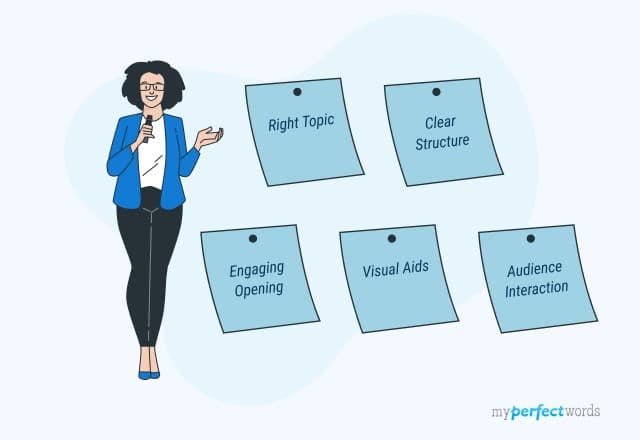

Improve your practice.
Enhance your soft skills with a range of award-winning courses.
Persuasive Speech Outline, with Examples
March 17, 2021 - Gini Beqiri
A persuasive speech is a speech that is given with the intention of convincing the audience to believe or do something. This could be virtually anything – voting, organ donation, recycling, and so on.
A successful persuasive speech effectively convinces the audience to your point of view, providing you come across as trustworthy and knowledgeable about the topic you’re discussing.
So, how do you start convincing a group of strangers to share your opinion? And how do you connect with them enough to earn their trust?
Topics for your persuasive speech
We’ve made a list of persuasive speech topics you could use next time you’re asked to give one. The topics are thought-provoking and things which many people have an opinion on.
When using any of our persuasive speech ideas, make sure you have a solid knowledge about the topic you’re speaking about – and make sure you discuss counter arguments too.
Here are a few ideas to get you started:
- All school children should wear a uniform
- Facebook is making people more socially anxious
- It should be illegal to drive over the age of 80
- Lying isn’t always wrong
- The case for organ donation
Read our full list of 75 persuasive speech topics and ideas .

Preparation: Consider your audience
As with any speech, preparation is crucial. Before you put pen to paper, think about what you want to achieve with your speech. This will help organise your thoughts as you realistically can only cover 2-4 main points before your audience get bored .
It’s also useful to think about who your audience are at this point. If they are unlikely to know much about your topic then you’ll need to factor in context of your topic when planning the structure and length of your speech. You should also consider their:
- Cultural or religious backgrounds
- Shared concerns, attitudes and problems
- Shared interests, beliefs and hopes
- Baseline attitude – are they hostile, neutral, or open to change?
The factors above will all determine the approach you take to writing your speech. For example, if your topic is about childhood obesity, you could begin with a story about your own children or a shared concern every parent has. This would suit an audience who are more likely to be parents than young professionals who have only just left college.
Remember the 3 main approaches to persuade others
There are three main approaches used to persuade others:
The ethos approach appeals to the audience’s ethics and morals, such as what is the ‘right thing’ to do for humanity, saving the environment, etc.
Pathos persuasion is when you appeal to the audience’s emotions, such as when you tell a story that makes them the main character in a difficult situation.
The logos approach to giving a persuasive speech is when you appeal to the audience’s logic – ie. your speech is essentially more driven by facts and logic. The benefit of this technique is that your point of view becomes virtually indisputable because you make the audience feel that only your view is the logical one.
- Ethos, Pathos, Logos: 3 Pillars of Public Speaking and Persuasion
Ideas for your persuasive speech outline
1. structure of your persuasive speech.
The opening and closing of speech are the most important. Consider these carefully when thinking about your persuasive speech outline. A strong opening ensures you have the audience’s attention from the start and gives them a positive first impression of you.
You’ll want to start with a strong opening such as an attention grabbing statement, statistic of fact. These are usually dramatic or shocking, such as:
Sadly, in the next 18 minutes when I do our chat, four Americans that are alive will be dead from the food that they eat – Jamie Oliver
Another good way of starting a persuasive speech is to include your audience in the picture you’re trying to paint. By making them part of the story, you’re embedding an emotional connection between them and your speech.
You could do this in a more toned-down way by talking about something you know that your audience has in common with you. It’s also helpful at this point to include your credentials in a persuasive speech to gain your audience’s trust.

Obama would spend hours with his team working on the opening and closing statements of his speech.
2. Stating your argument
You should pick between 2 and 4 themes to discuss during your speech so that you have enough time to explain your viewpoint and convince your audience to the same way of thinking.
It’s important that each of your points transitions seamlessly into the next one so that your speech has a logical flow. Work on your connecting sentences between each of your themes so that your speech is easy to listen to.
Your argument should be backed up by objective research and not purely your subjective opinion. Use examples, analogies, and stories so that the audience can relate more easily to your topic, and therefore are more likely to be persuaded to your point of view.
3. Addressing counter-arguments
Any balanced theory or thought addresses and disputes counter-arguments made against it. By addressing these, you’ll strengthen your persuasive speech by refuting your audience’s objections and you’ll show that you are knowledgeable to other thoughts on the topic.
When describing an opposing point of view, don’t explain it in a bias way – explain it in the same way someone who holds that view would describe it. That way, you won’t irritate members of your audience who disagree with you and you’ll show that you’ve reached your point of view through reasoned judgement. Simply identify any counter-argument and pose explanations against them.
- Complete Guide to Debating

4. Closing your speech
Your closing line of your speech is your last chance to convince your audience about what you’re saying. It’s also most likely to be the sentence they remember most about your entire speech so make sure it’s a good one!
The most effective persuasive speeches end with a call to action . For example, if you’ve been speaking about organ donation, your call to action might be asking the audience to register as donors.
Practice answering AI questions on your speech and get feedback on your performance .
If audience members ask you questions, make sure you listen carefully and respectfully to the full question. Don’t interject in the middle of a question or become defensive.
You should show that you have carefully considered their viewpoint and refute it in an objective way (if you have opposing opinions). Ensure you remain patient, friendly and polite at all times.
Example 1: Persuasive speech outline
This example is from the Kentucky Community and Technical College.
Specific purpose
To persuade my audience to start walking in order to improve their health.
Central idea
Regular walking can improve both your mental and physical health.
Introduction
Let’s be honest, we lead an easy life: automatic dishwashers, riding lawnmowers, T.V. remote controls, automatic garage door openers, power screwdrivers, bread machines, electric pencil sharpeners, etc., etc. etc. We live in a time-saving, energy-saving, convenient society. It’s a wonderful life. Or is it?
Continue reading
Example 2: Persuasive speech
Tips for delivering your persuasive speech
- Practice, practice, and practice some more . Record yourself speaking and listen for any nervous habits you have such as a nervous laugh, excessive use of filler words, or speaking too quickly.
- Show confident body language . Stand with your legs hip width apart with your shoulders centrally aligned. Ground your feet to the floor and place your hands beside your body so that hand gestures come freely. Your audience won’t be convinced about your argument if you don’t sound confident in it. Find out more about confident body language here .
- Don’t memorise your speech word-for-word or read off a script. If you memorise your persuasive speech, you’ll sound less authentic and panic if you lose your place. Similarly, if you read off a script you won’t sound genuine and you won’t be able to connect with the audience by making eye contact . In turn, you’ll come across as less trustworthy and knowledgeable. You could simply remember your key points instead, or learn your opening and closing sentences.
- Remember to use facial expressions when storytelling – they make you more relatable. By sharing a personal story you’ll more likely be speaking your truth which will help you build a connection with the audience too. Facial expressions help bring your story to life and transport the audience into your situation.
- Keep your speech as concise as possible . When practicing the delivery, see if you can edit it to have the same meaning but in a more succinct way. This will keep the audience engaged.
The best persuasive speech ideas are those that spark a level of controversy. However, a public speech is not the time to express an opinion that is considered outside the norm. If in doubt, play it safe and stick to topics that divide opinions about 50-50.
Bear in mind who your audience are and plan your persuasive speech outline accordingly, with researched evidence to support your argument. It’s important to consider counter-arguments to show that you are knowledgeable about the topic as a whole and not bias towards your own line of thought.
My Speech Class
Public Speaking Tips & Speech Topics
Informative Speech Outline – Template & Examples

Jim Peterson has over 20 years experience on speech writing. He wrote over 300 free speech topic ideas and how-to guides for any kind of public speaking and speech writing assignments at My Speech Class.

Informative speeches are used in our day-to-day lives without even noticing it, we use these speeches whenever we inform someone about a topic they didn’t have much knowledge on, whenever we give someone instructions on how to do something that they haven’t done before, whenever we tell someone about another person. Informative speaking is fairly new to the world of public speaking. Ancient philosophers like Aristotle, Cicero and, Quintilian envisioned public speaking as rhetoric, which is inherently persuasive.
In this article:
What is an Informative Speech?
Here are some ways to prepare for your speech, 1. develop support for your thesis, 2. write your introduction and conclusion, 3. deliver the speech, example of an informative speech outline.

An informative speech is designed to inform the audience about a certain topic of discussion and to provide more information. It is usually used to educate an audience on a particular topic of interest. The main goal of an informative speech is to provide enlightenment concerning a topic the audience knows nothing about. The main types of informative speeches are descriptive, explanatory, demonstrative, and definition speeches. The topics that are covered in an informative speech should help the audience understand the subject of interest better and help them remember what they learned later. The goal of an informative speech isn’t to persuade or sway the audience to the speaker’s point of view but instead to educate. The details need to be laid out to the audience so that they can make an educated decision or learn more about the subject that they are interested in.
It is important for the speaker to think about how they will present the information to the audience.
Informative Speech Preparation

When you are preparing your informative speech, your preparation is the key to a successful speech. Being able to carry your information across to the audience without any misunderstanding or misinterpretation is very important.
1. Choose Your Topic
Pick a topic where you will explain something, help people understand a certain subject, demonstrate how to use something.
2. Make a Thesis Statement
Think about what point you are trying to get across, What is the topic that you want to educate your audience on? “I will explain…” “I will demonstrate how to…” “I will present these findings…”
Can We Write Your Speech?
Get your audience blown away with help from a professional speechwriter. Free proofreading and copy-editing included.
3. Create Points That Support Your Thesis
Take a moment to think about what would support your thesis and take a moment to write the points down on a sheet of paper. Then, take a moment to elaborate on those points and support them.
Typical Organization for an Informative Speech:
How to Speech: 4 Key steps to doing what you are talking about.
Example: Step One: Clean the chicken of any unwanted feathers and giblets. Step Two: Spice the chicken and add stuffings. Step Three: Set oven to 425 degrees Fahrenheit. Step Four: Place chicken in the oven and cook for an hour.
History/ What Happened Speech: Points listing from the beginning to the latest events that you want to discuss in your speech.
Example: First, Harry met Sally. Second, Harry took Sally out to the roadhouse. Third, Harry and Sally started their courtship. Fourth, Harry and Sally moved in together and adopted a dog named Paco.
What is it Speech: Two to Four main points that discuss the key elements of your subject.
Example: First, there must be four wheels. Second, the car’s engine must be functioning. Third, the doors must be functional. Fourth, in order to get to your destination, the car’s steering has to be functional.
Explain it Speech: Two to Four main points that go through the key elements of the topic to explain it.
Example: Firstly, the car drives by the engine that powers it to move forward. Secondly, by the wheels that rotate in a forward or backward motion. Thirdly, the car’s engine is powered by gas which gives it the ability to function and essentially move the car.
Write down support for your points. Take some time to research your topic thoroughly. It is good to gather statistics, expert opinions, facts, and much more to make your speech unique and effective.
There are three main types of support you should use to strengthen your speech:
Interest supports.
Interest supports are used to increase the audience’s interest in the topic you are presenting.
- Personal experiences
- Interaction (e.g., Questions to the audience)
Evidence Supports
Evidence increases solid factual support in your speech. Examples of evidence supported are statistics, expert opinions, direct quotations. Studies, surveys, and facts.
Multimedia Aids
Multimedia aids such as posters with pictures and writing, DVDs, music or recordings on a stereo player, videotapes, and PowerPoint presentations.
Write your introduction. Provide a quick attention getter, state your thesis, elaborate on why it is important to you and your audience. It is expected that you preview your main points in the introduction by listing all your main points of discussion in your introduction.
Write your conclusion. Tie the speech together, build to a higher point and give it a sense of conclusion.
Practice your speech until you feel confident. Present your material as effectively as possible.
Informative Speech Outline

Creating an outline for an informative speech will help you organize your ideas and information to share with your audience in an effective manner. A well-planned outline will ensure that all the important information is included in your speech and ensure that you don’t wander off-topic.
Topic: This will be the title of your speech.
Purpose: To inform the audience about the topic.
Thesis: A theme statement that clearly describes the topic and points made in the presentation.
- Introduction
- Attention-grabbing opening statement
- Reason to listen to the speech
- Thesis statement
- Preview of points to be covered
- First main point
- First subpoint
- Supporting detail
- Second subpoint
- Second main point
- Third main point
- Restatement of main points
- Restatement of thesis
- Concluding remarks
When developing an outline, follow these rules to ensure a successful speech:
- Include one idea for every point, subpoint, or supporting detail.
- If there is one point, there must be a second point. If there is one supporting point, there should be a second supporting point.
- Be consistent. If you are using full sentences to describe points and subpoints, use full sentences throughout the outline. Ensure that the verb tense is consistent throughout your outline as well.
Informative Speech Outline Examples

Topic: Adoption
Purpose: To inform people about adoption
Thesis: Adoption is the act of transferring parental rights and duties to someone other than the adopted person’s biological parents. The number of children adopted each year by American families is an estimate only.
- What do Edgar Allan Poe, John Lennon, Steve Jobs, and Eleanor Roosevelt all have in common? They were all adopted. Adoption is the act of transferring parental rights and duties to someone other than the adopted person’s biological parents. The adoption process is lengthy, expensive, and varies from country to country and even state to state. Not only does adoption vary from state to state, but sometimes the adoption process even varies within regions of a state.
- Many children get adopted every year. No one knows how adoption works.
- Adoption is a life-changing event, not just for the children involved but also for every single family made whole through adoption.
- Adoption processes vary from place to place. Types of adoption. Benefits and detriments to adoption. Many children who are adopted have experienced neglect and abuse.
- Adoption processes vary from place to place.
- The adoption process varies from state to state.
- It is more expensive in certain states than in others.
- The amount of paperwork throughout the process also depends on the state legislature.
- The adoption process varies within a state.
- In certain states, the adoption process is different from one region to the next.
- The process is different depending on the child protection laws set in each region inside a state.
- Types of adoption
- There are different types of adoption.
- There is step-parent or other family member adoption
- There is also adoption across state lines
- The more traditional adoption types are commonly known.
- There is private adoption which is most commonly found throughout the U.S.
- Adoption through foster care is a good thing to try for first-time adopters.
- The adoption process is expensive.
- There are a lot of upfront expenses.
- You are subjected to adoption agency fees to help you find a suitable match for your family.
- You also have to pay to adopt the child you want to adopt.
- There are a lot of big expenses in terms of the child too.
- Readying a living space to suit a child’s wants and needs can be expensive.
- Many new expenses come to light like healthcare, school, etc.
- Adoption processes vary from state to state. There are many different types of adoption. Adoption can be expensive, so you have to ensure that you are financially capable of caring for another human being.
- Adoption is the act of transferring parental rights and duties to someone other than the adopted person’s biological parents. The number of children adopted each year by American families is an estimate only.
- Adoption is an absolutely life-changing adventure, but everyone needs to be more educated before walking into a demanding process. There will be many emotions, expenses, and frustration, but it truly is worth it in the end.
Topic: Snakebites and how they’re treated
Purpose: To inform the audience of the dangers of snakes and how to respond to being bitten by a snake.
Thesis: Snakebites are dangerous and could ultimately lead to loss of life if not acted upon correctly.
- Imagine that you and your friend are walking in the woods, one sunny day in the fall when leaves cover the ground. Suddenly, your friend accidentally steps on a snake and gets bitten.
- Your friend’s chance of survival depends on your knowledge of acting promptly and taking proper measures in this situation.
- Today I will inform you about three common poisonous snakes seen in our country and explain to you the effects of a snake bite.
- Three poisonous snakes. Effects of the snake’s venom. How to administer first aid in the event of a snake bite.
- Three poisonous snakes
- There are two types of Rattlesnakes.
- William Pinkston: Responsible for more deaths in this country.
- Western diamondback: found from Texas to Eastern California.
- Copperhead and Cottonmouth
- Before striking, it opens its mouth wide to reveal its white inside.
- That’s how it got its name.
- The effects of snake venom on the human body
- Hepatotoxic
- Destroys blood vessels and red blood cells.
- Deadly and fatal to the victim.
- It affects the optic nerves in the eyes, causing blindness.
- It affects the nerves controlling the respiratory muscles, causing suffocation and eventually leading to death if left untreated.
- How to administer first aid in the event of a snake bite.
- Immobilize the bitten area slightly lower than the heart.
- Apply a flat constricting band 2-4 inches above the bite.
- With a sterile scalpel or knife, make one incision that connects the fang marks.
- Squeeze venom gently from the incision with your fingers for 30 minutes.
- Get the victim to the hospital as soon as possible.
- Snake bites are dangerous and could ultimately lead to loss of life if not acted upon correctly.
- Snake bites are dangerous and could ultimately lead to loss of life if they are not cared for properly, and the victim doesn’t get the necessary treatment in time.
Informative speeches have one main goal: to inform the audience of a specific topic of interest. For you to have an effective and successful informative speech, it is important to do your research and draw up an informative speech outline. The speech outline ensures that you do not wander off topic or get carried away with one point.
If, on the other hand, you have to prepare persuasive speech, we have a guide on outlining and preparing for it the right way right here .
Avoid Any Awkward Silence With These 35+ Topics to Talk About
16 Tips to Help You Write Like a Pro
Leave a Comment
I accept the Privacy Policy
Reach out to us for sponsorship opportunities
Vivamus integer non suscipit taciti mus etiam at primis tempor sagittis euismod libero facilisi.
© 2024 My Speech Class

Speech Outline Template – 38+ Samples, Examples and Formats
Often, when we approach public speaking we tend to view the individual speech in the broad terms of what a speech is rather than the details of what a speech is made of. The perfect speech outline is important because the task requires the speaker to lay out the details of the speech which lends confidence on the podium. The basic speech outline also works to highlight what is not needed in the speech and what is most important. A basic speech outline template provides the tool to achieve this confidence and cohesion in the delivery of the speech.
A basic speech outline is very simple and goes a little something like this.
Everything we do in communication starts with a greeting of some kind. New business and acquaintance introductions being with a greeting; our mornings begin with a greeting; telephone calls; office memos; even shopping begins with a greeting. Delivering a speech is no different. Just like any other greeting, when speaking publicly, your speech should have a simple greeting that includes who you are.
This is also a good time to publicly thank the appropriate individuals or institutions. If you’re speaking at a charity function, mention a quick thanks to its host. If you were introduced before taking the podium then thank the person who introduced you. At the very least, thank the audience for their attendance and attention.
Get your audience’s attention. Tell a joke, or mention a curious fact that is out of scope for your speech but relevant to the audience. Consider the audience rather than the speaker here. This is where you cast the bait to hook their attention.
Into the subject matter: This is a very brief transition that will allow you, the speaker, to move from your introductions and into the content matter of your speech.
Make your point:
If your speech is informative in nature then summarize the contents of that information here. If your speech is argumentative then state your position. If your speech is of scientific matter then state your theses.
Credentials:
Have you ever listened to someone talk or speak and wonder why they’re commenting on specific content? Or have you ever watched a debate and thought: “Wow, she really knows what she’s talking about?” When delivering a speech you’ll want more of the latter, and none of the former. Tell your audience why you’re qualified to speak on the subject at hand. This doesn’t have to be a list of degrees. It can be the occasion that led you being invited or asked to give a speech.
This is a brief overview of the main points of your speech. This can be as simple as a brief statement that voices the headers in your outline.
The Main body:
This is the main content of your speech and the reason for your podium visit. This section is the most structured portion of your speech and your speech outline . It’s also the reason why so much importance is ascribed to a speech outline.
The structure here is:
First point or strongest argument
Supporting evidence
Transition to next point
When developing your speech body, consider your time limits. If the purpose of your speech is to provide an argument time restraints may only allow for three to five points. If you’re a guest speaker at a conference with a 90 minute slot, organization here will be the key to keeping your audience’s attention.
Signal to the end:
It’s a short transition that signals your audience that your speech is nearing its end. Summarize your main points and remember that the time to introduce information is in your speech body, not here.
Restate your original thesis, argument or summary.
Final thoughts:
Your final thoughts should be a statement that will leave your audience something to remember.
Exit gracefully:
A quick Thank You for the audience’s attention and the opportunity to speak. This should be short and sweet. Don’t linger. Just say give your thanks, and exit stage left.
Here are some templates to help you:
Table of Contents
Basic Speech Outline Template

Free Download
Basic Speech Outline for PDF

Speech Outline Format

Informative Speech Outline Template
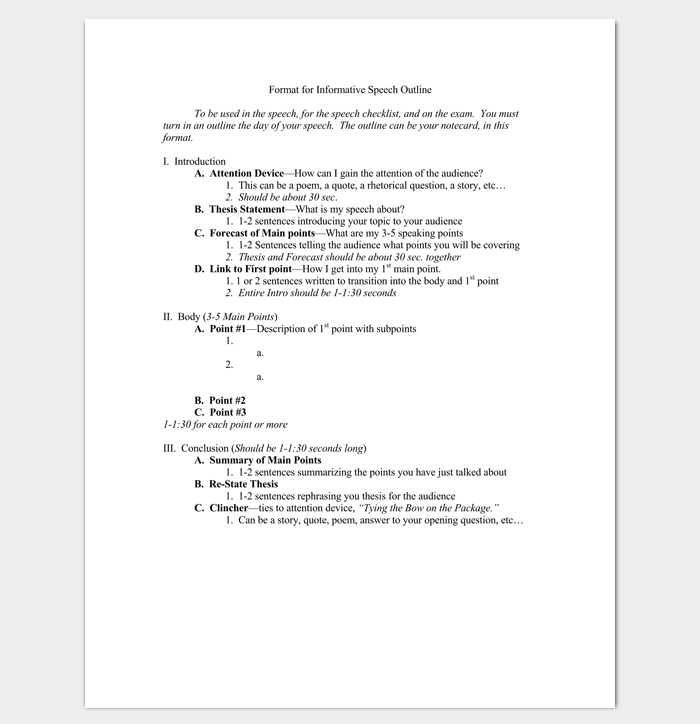
Sample Informative Speech Outline Template for PDF

Informative Speech Outline Example

Preparation Outline Template for Introduction Speech

Introduction Speech Outline Example
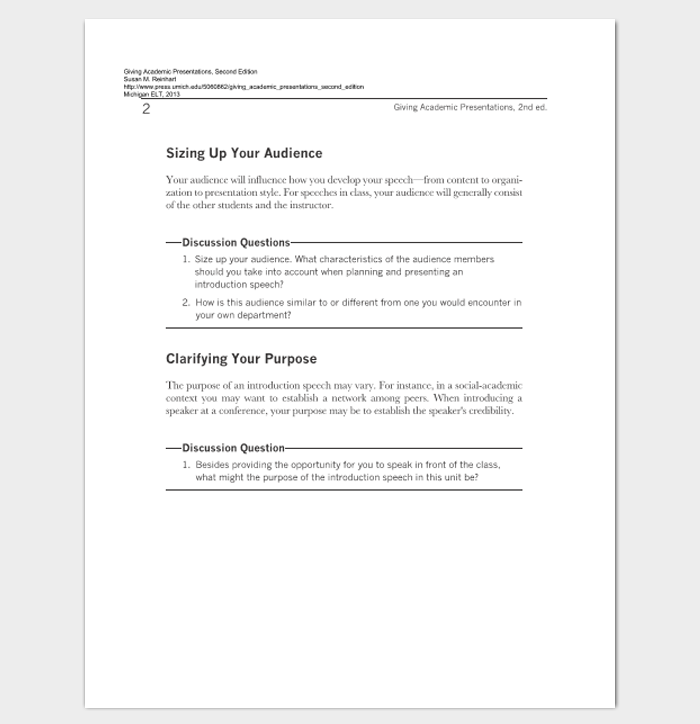
Sample Introduction Speech Outline

Self Introduction Speech Outline Template

Speech Preparation Outline Sample

Speech Preparation Outline Example
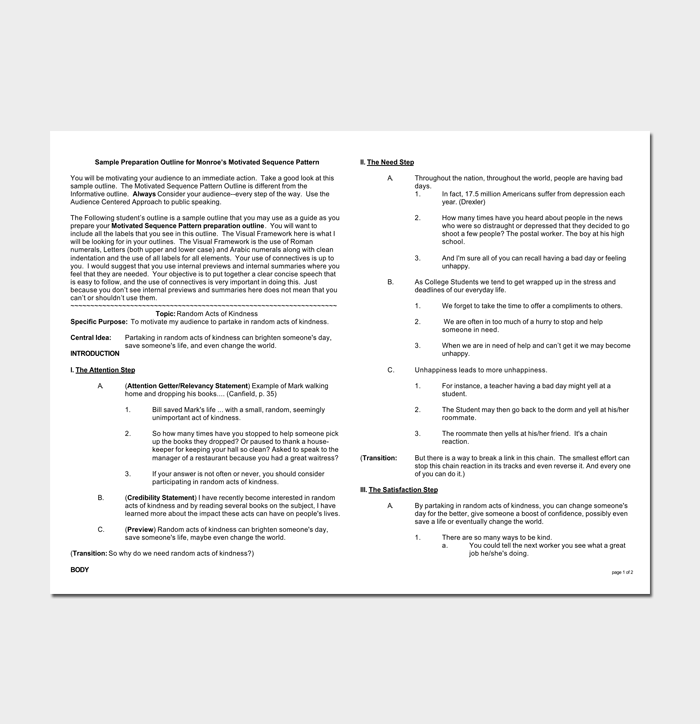
Expository Speech Outline Template

Demonstration Speech Outline Template
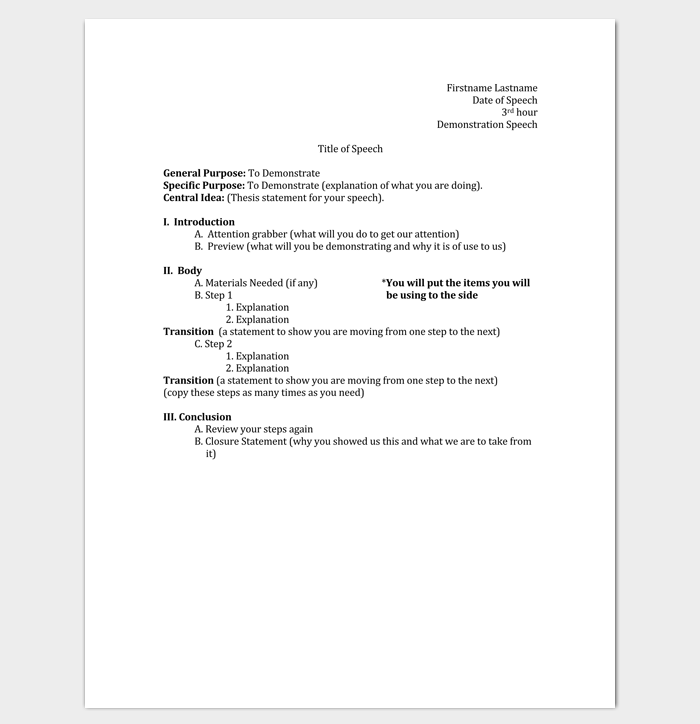
Demonstrative Speech Outline Example
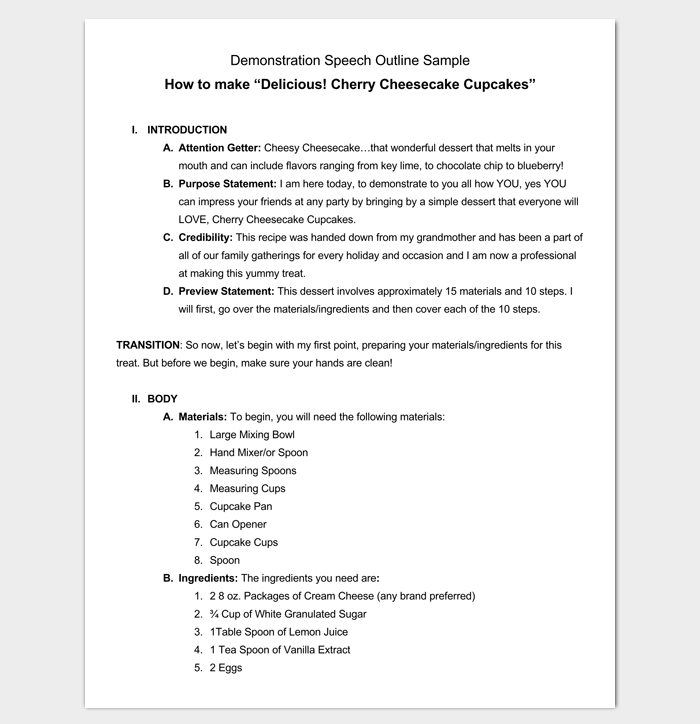
Demonstration Speech Outline Sample

Formal Speech Outline Template for Word

Commemorative Speech Outline Example
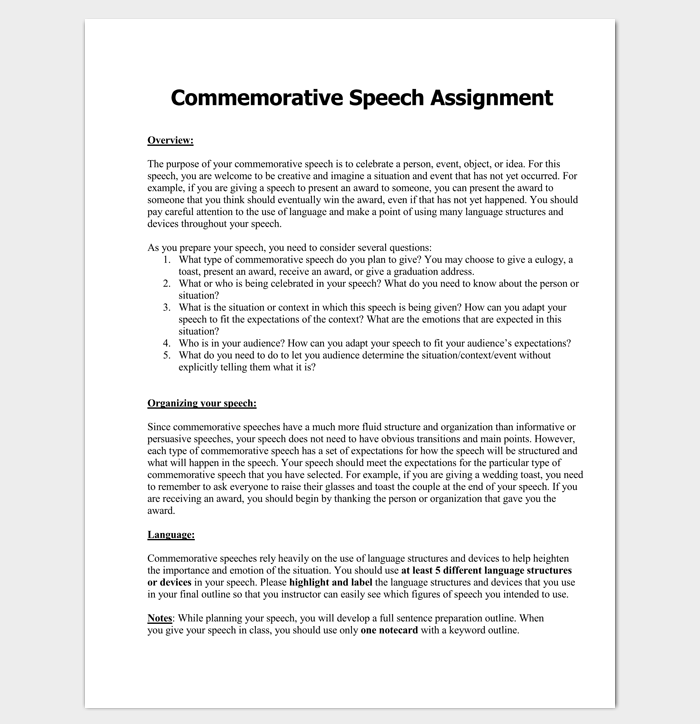
Sample Commemorative Speech

Elevator Speech Outline Example

Eulogy Speech Outline Example

Extemporaneous Speech Outline for PDF

Extemporaneous Speech Outline Sample

Persuasive Speech Outline Template for Word

Individual Persuasive Speech Outline Template

Persuasive Speech Outline Template (Plus Guide)

Persuasive Speech Outline for PDF

Sample Persuasive Speech Outline

Speech Outline Sample Format

Sample Acceptance Speech Outline

Gradation Speech Outline Example

Narrative Speech Outline

Ceremonial Speech Outline Sample

Speech Presentation Outline Example

Special Occasion Speech Outline Template for Word

Persuasion Speech Outline Template for PDF

Career Speech Outline Template for PDF

Hero Speech Outline for PDF
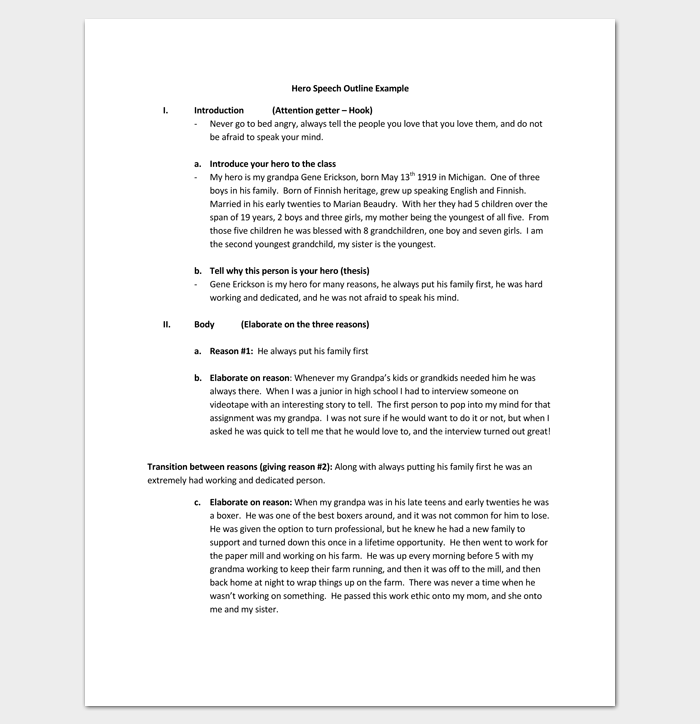
Speech Outline Format and Reference Guide

Some tips for preparing a speech outline:
- Most speeches or speech outlines will only have three to five main points- Making decisions about what is most important and relevant to your audience is a process greatly aided by the speech outline
- The average audience will give a speaker about 7 minutes before losing interest- This is neither conscious nor intentional. Stand-up comedy acts are just about the only exception to this rule. However, even with this allowance the speaker must still gain the audience’s attention. This need not be humiliating or extravagant. It can be as simple as a clean, quick joke; a relevant short poem; a simple quote; or an interesting fact.
- Practice your speech- Practice your speech in front of a mirror with a stopwatch to perfect your pace, delivery, and body language.
- Write it out- When assembling your speech outline write out your greeting, hook, thesis or main argument, credentials, preview, and transition statements in full sentences to prefect them and their delivery.
- Know your audience- Knowing your audience and fully understanding the purpose of your speech will better help you to make decisions on important points. .
- A properly completed speech outline organizes speech delivery so that the audience can make sense of what they’re hearing. A well developed and delivered speech lends credibility to the speaker and to the organization they are speaking for.
Share this:
- Click to share on Twitter (Opens in new window)
- Click to share on Facebook (Opens in new window)
Add comment
- Agenda Templates
- Agreement Templates
- Certificates Templates
- Envelopes Templates
- Invoices Templates
- Lists Templates
- Letterhead Templates
- Memos Templates
- MOU Templates
- Minutes Templates
- Resumes Templates
- Receipts Templates
- Budgets Templates
Advertisements
- Certificates
- Marriage Certificates
All Formats
Outline Templates
29+ speech outline templates – pdf, doc.
When you download a free speech outline template sample, you will find that this premium template helps you to clarify what you wish to say to the audience as well as organize all the print material you have in an easy and reliable manner. The Outline Template decreases the burden of having to draw up rough drafts of the speech and in the long run, will be instrumental in helping you save precious time.
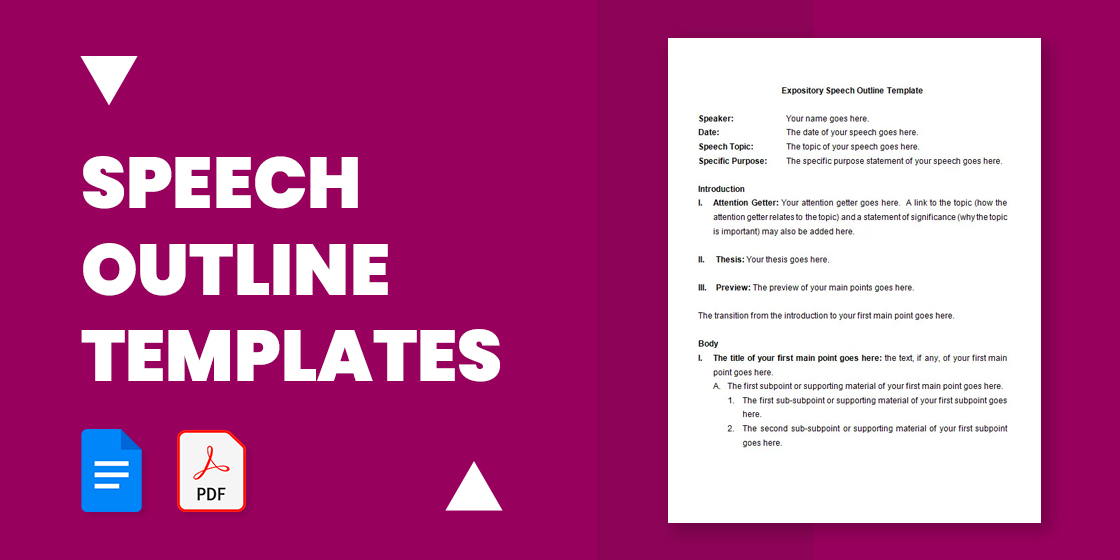
- Outline Templates in PDF
- Outline Templates in Word
Example of Sample Informative Speech OutlineTemplate in PDF Format
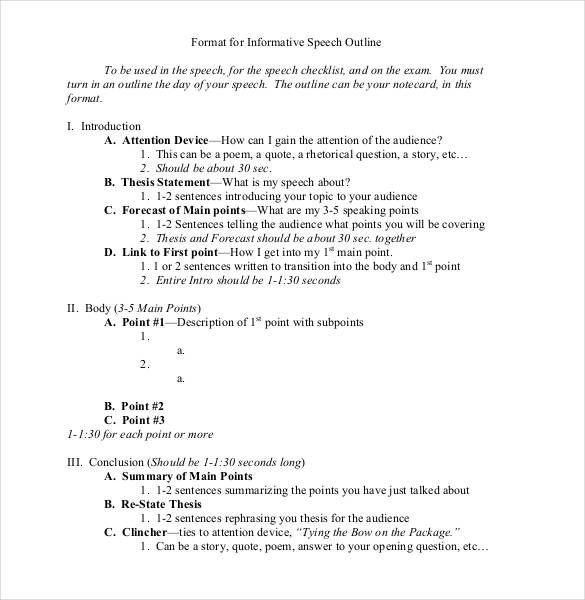
Introduction Speech Preparation Outline Template Free
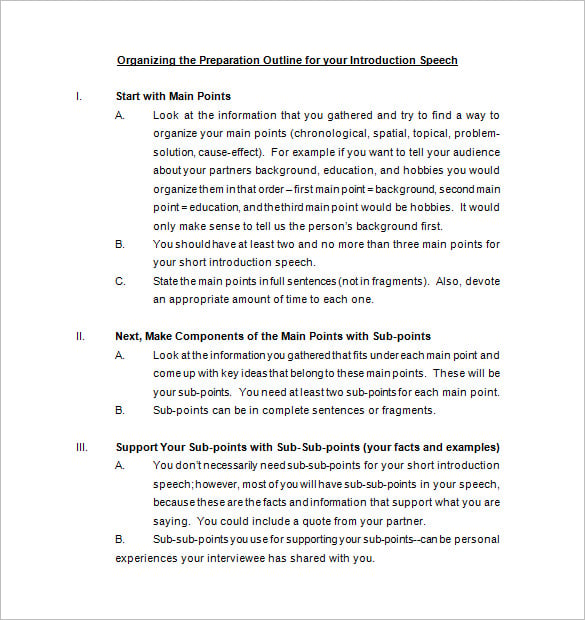
Public Expository Speech Outline Template Download in Word Format
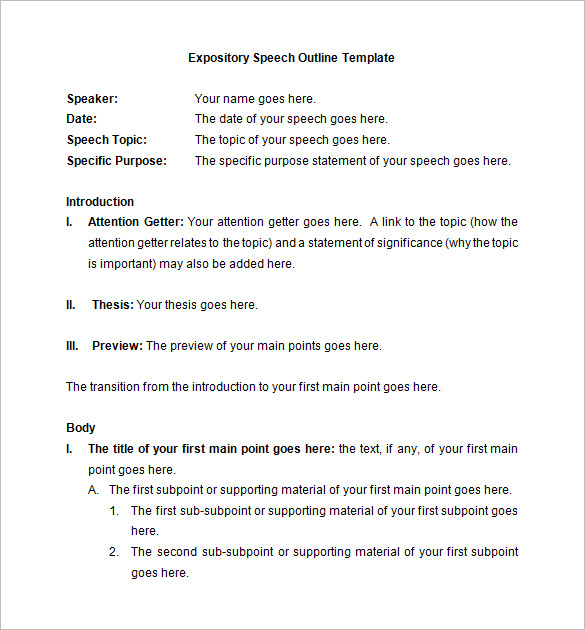
Download Demonstration Speech Outline Template
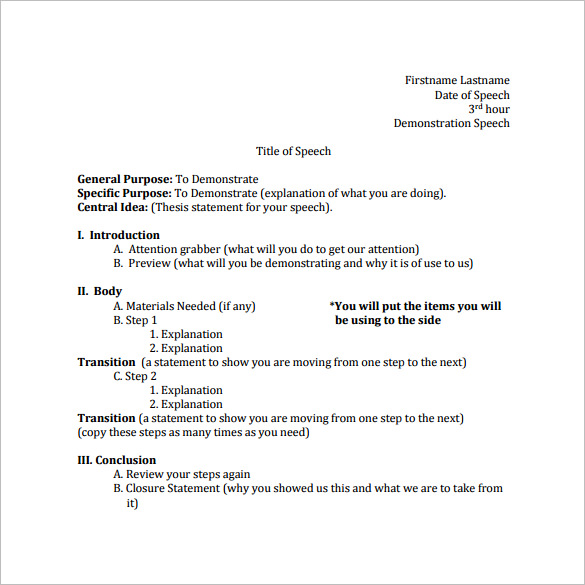
Individual Persuasive Speech Outline Template In PDF Format
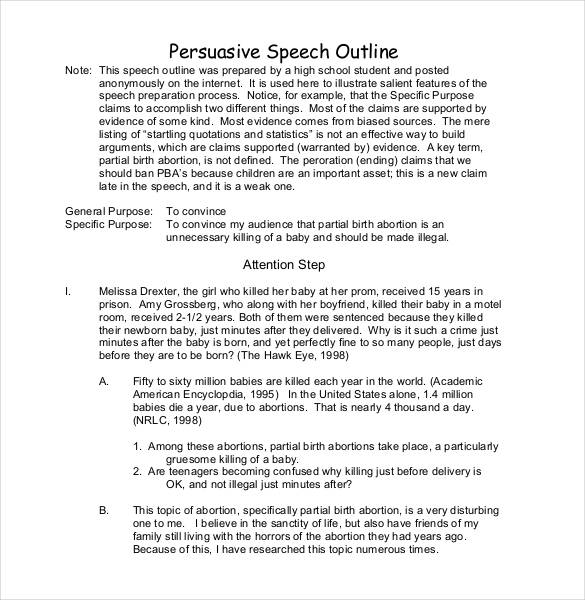
Blank Outline for Persuasive Speech
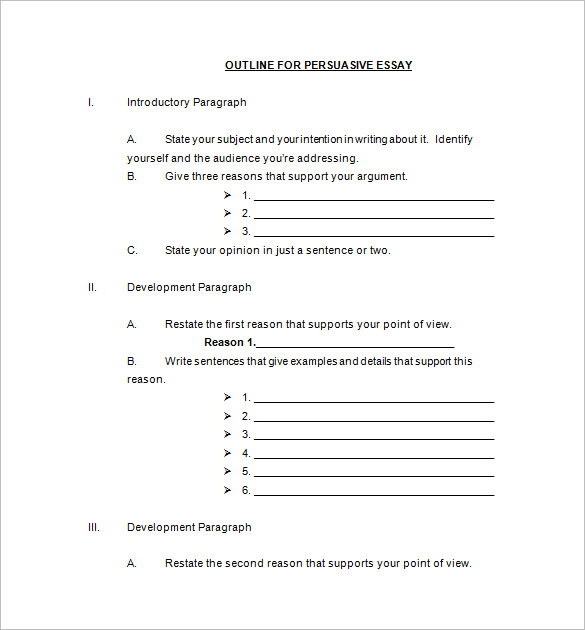
Template for Draft Speech Outline
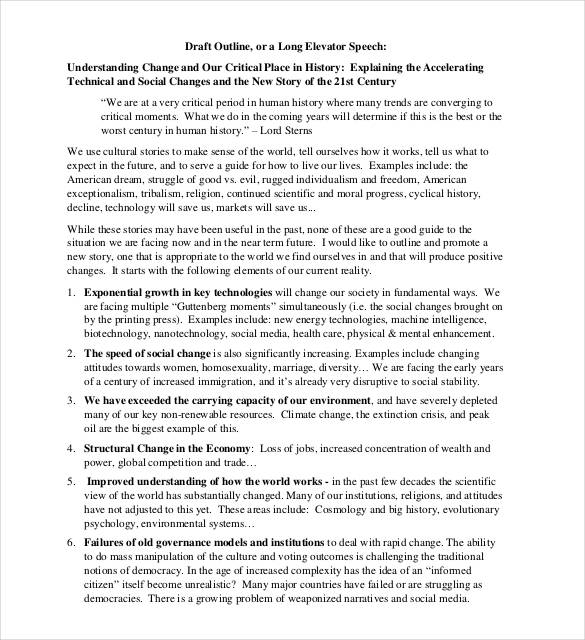
Speaking Outline Template Example
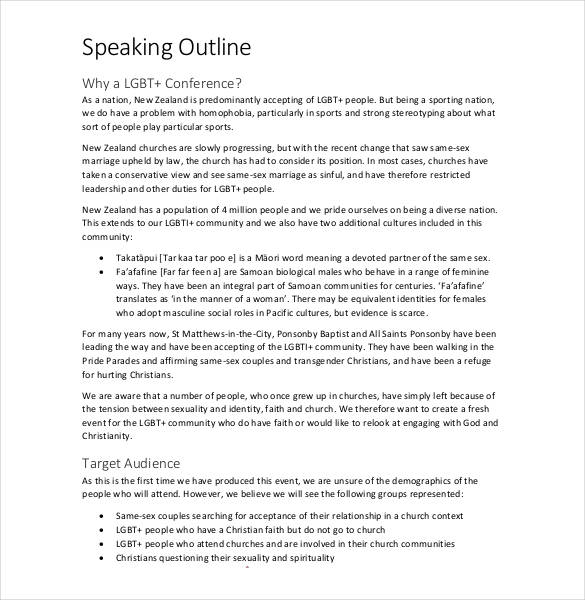
Example of a Demonstrative Speech Outline
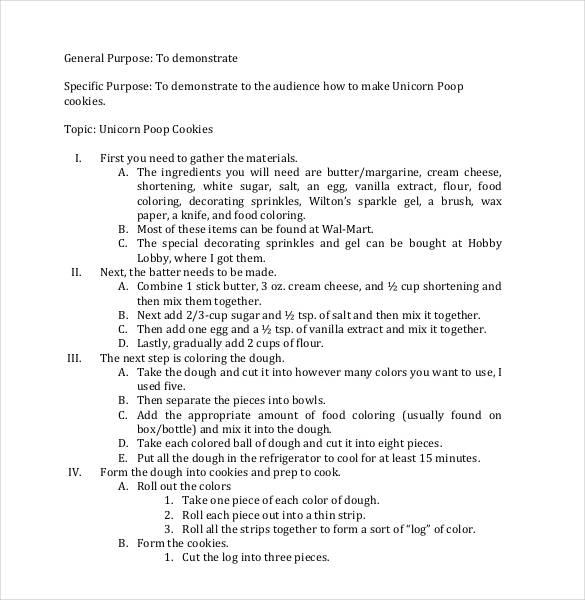
Free Speech Preparation Outline
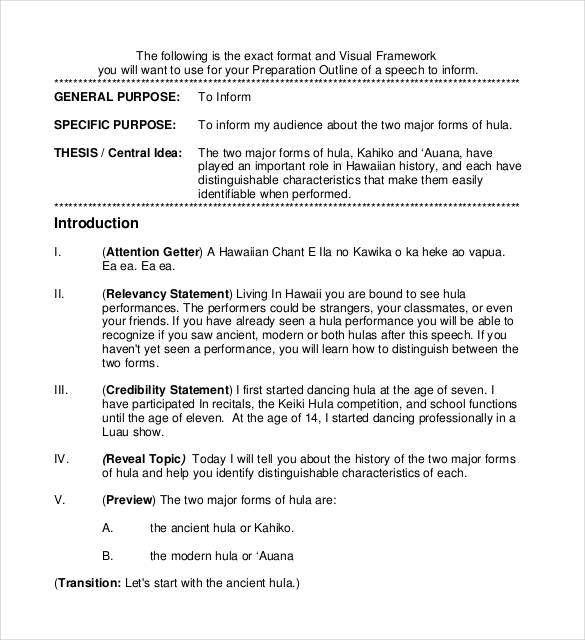
Speech Plan Outline
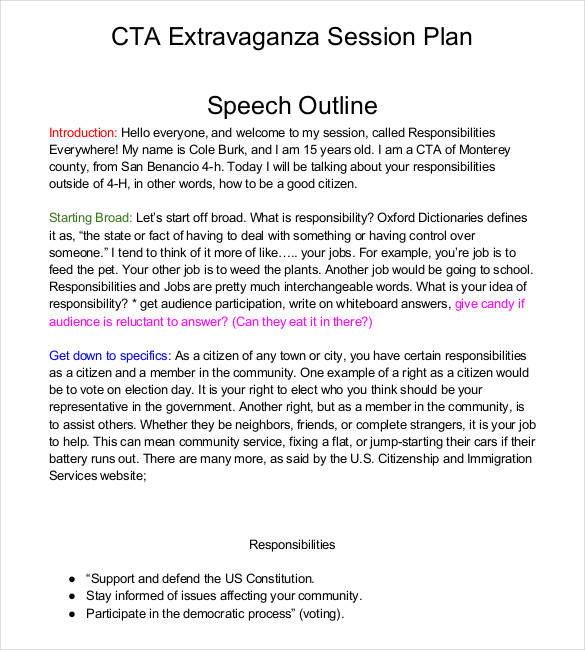
Self Introduction Speech Outline
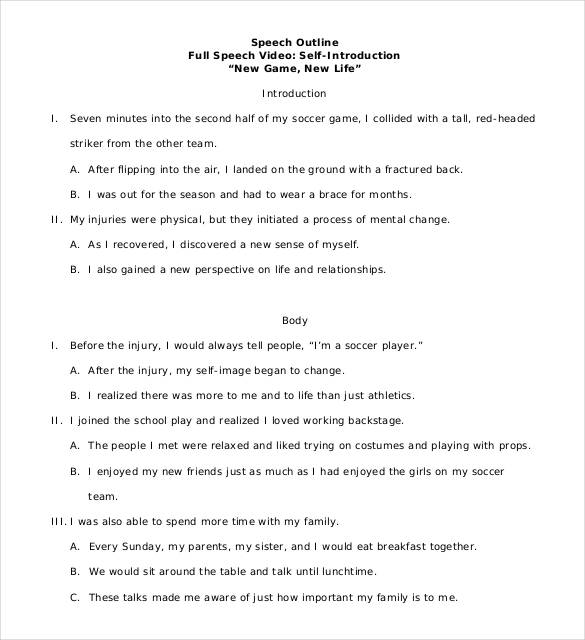
Controversial Speech Outline Structure
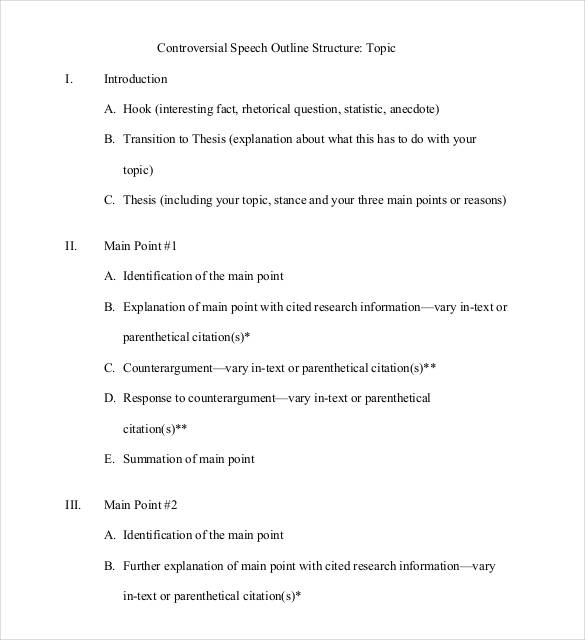
Sample of Instructional Speech Outline
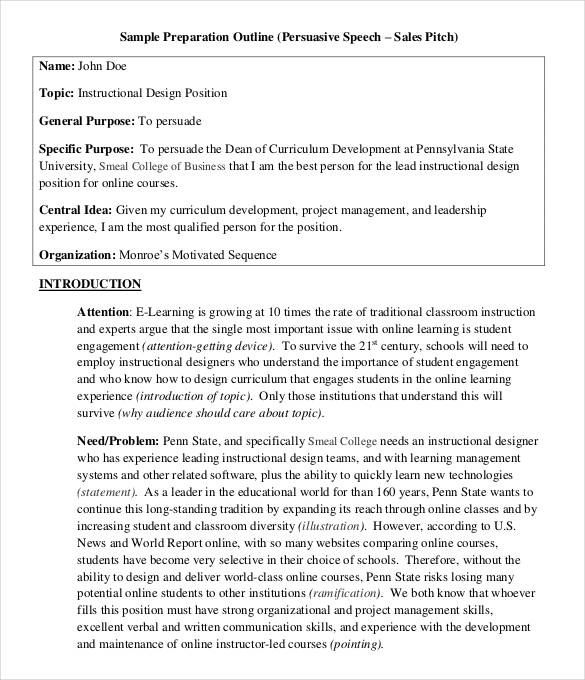
Informal Outline for Speech Planning
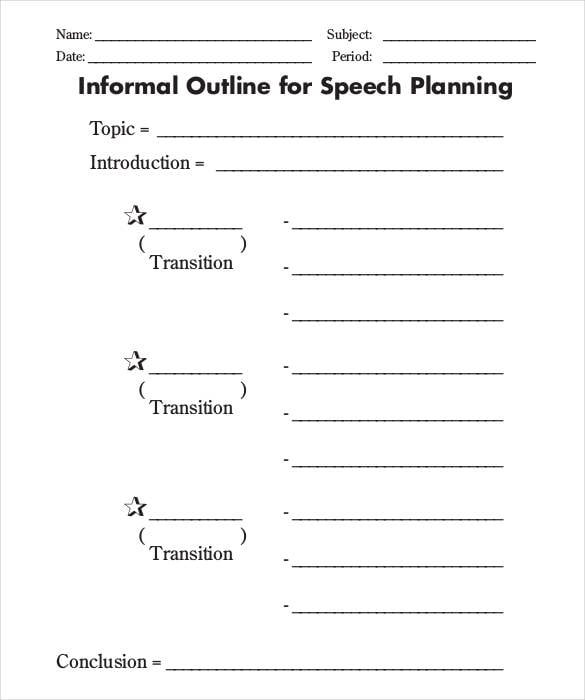
Persuasive Speech Layout
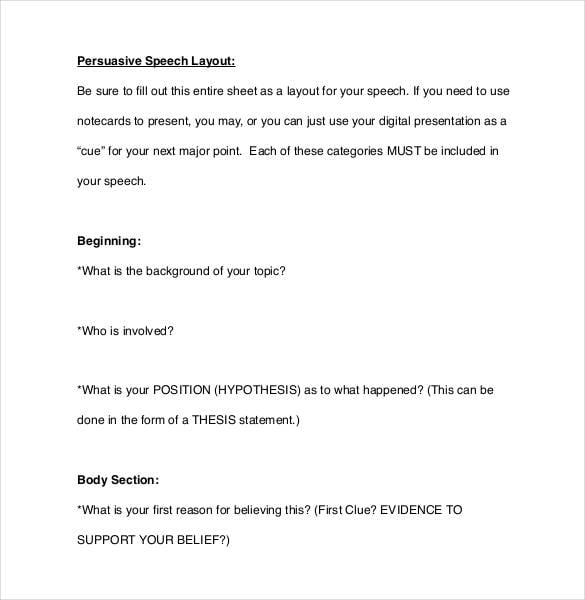
Free Printable Expository Speech Layout

Career Speech Outline Format Example
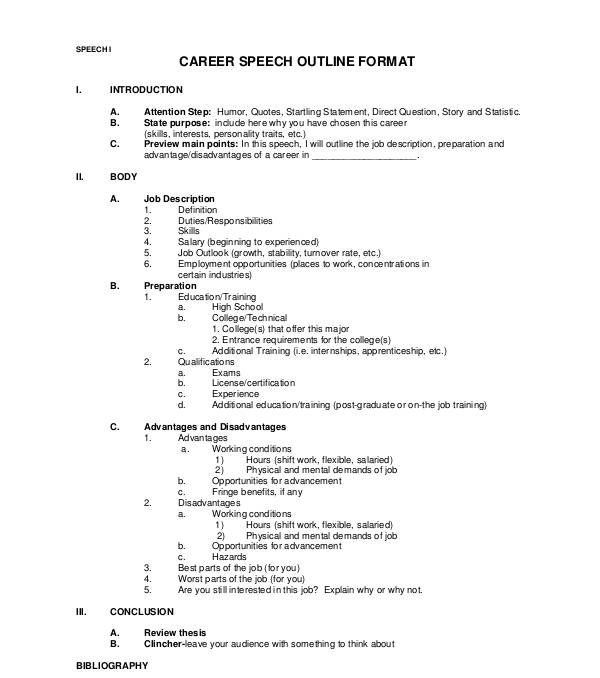
Demo Speech Outline Worksheet
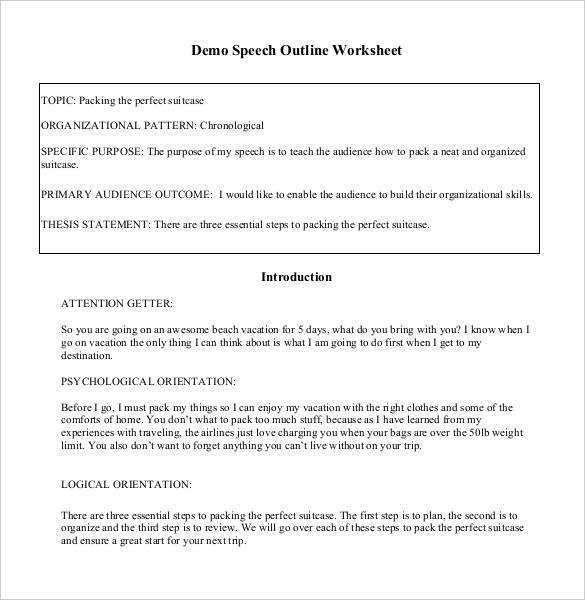
Blank Graduation Project Speech Outline
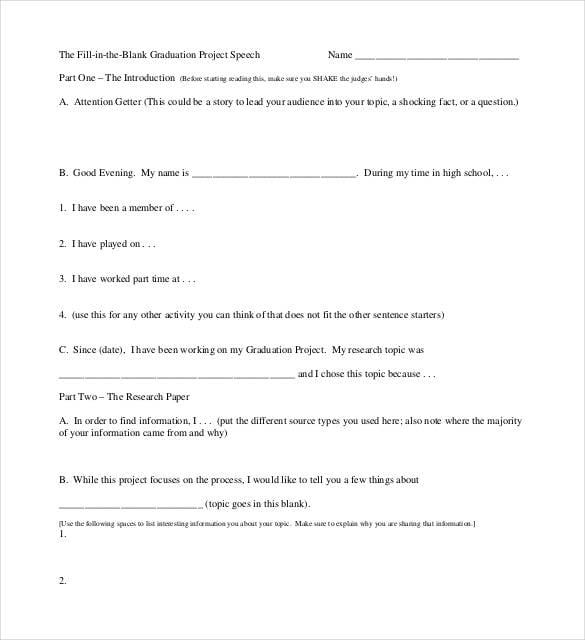
Career Research Informative Speech Outline

Graduation Speech Outline
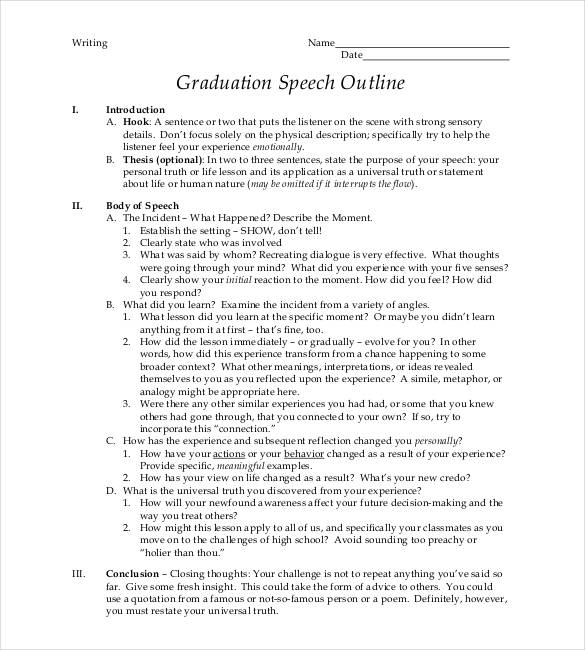
Narrative Speech Outline
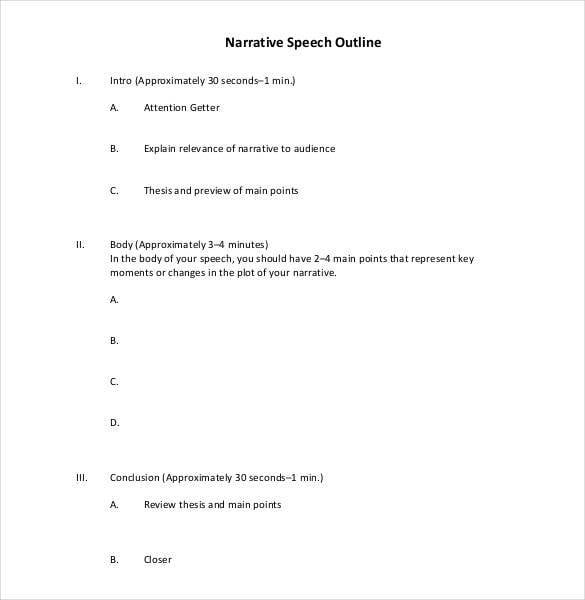
Short Speech Outline

Simple Process Speech Outline Example
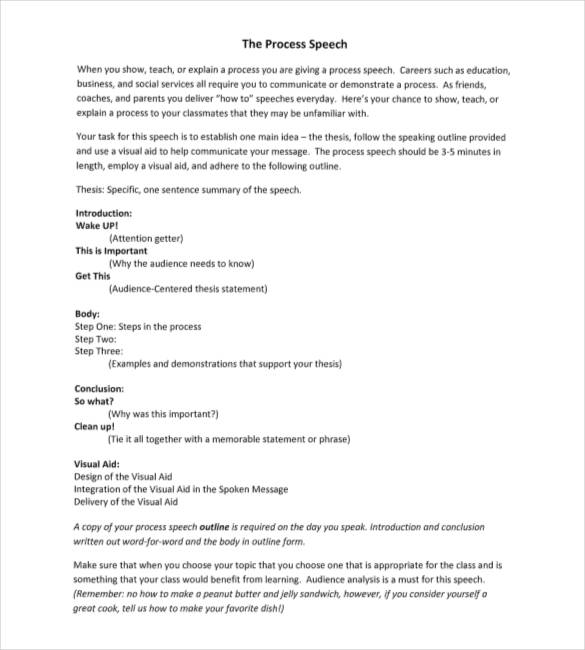
Introductory Speech Outline
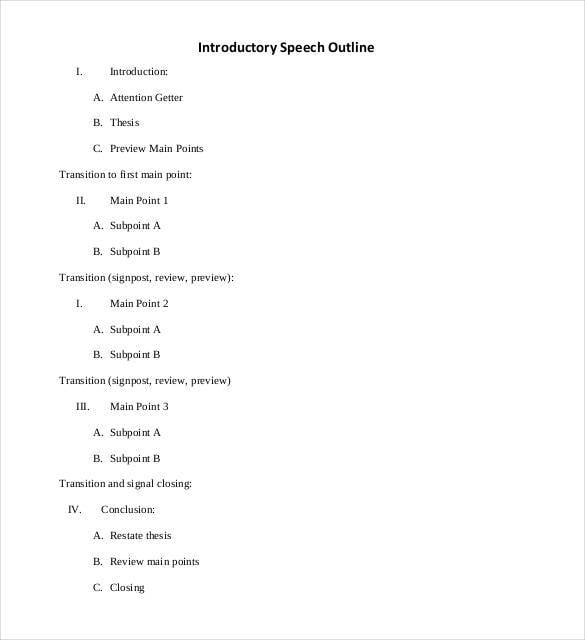
Interview Speech Outline
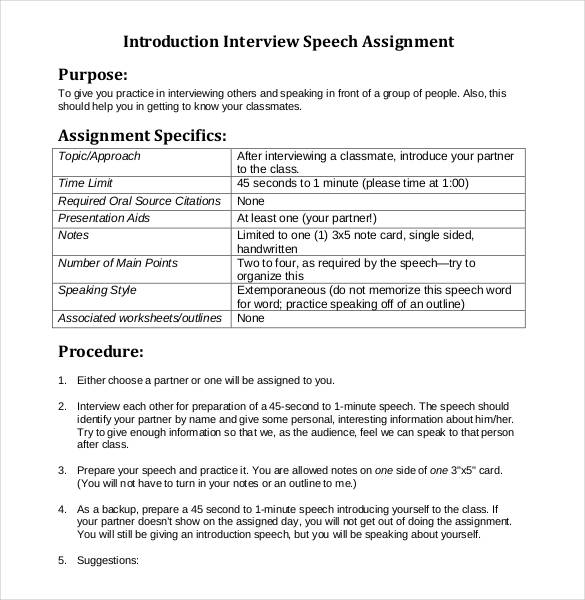
Elevator Speech Outline

Event Speech Outline
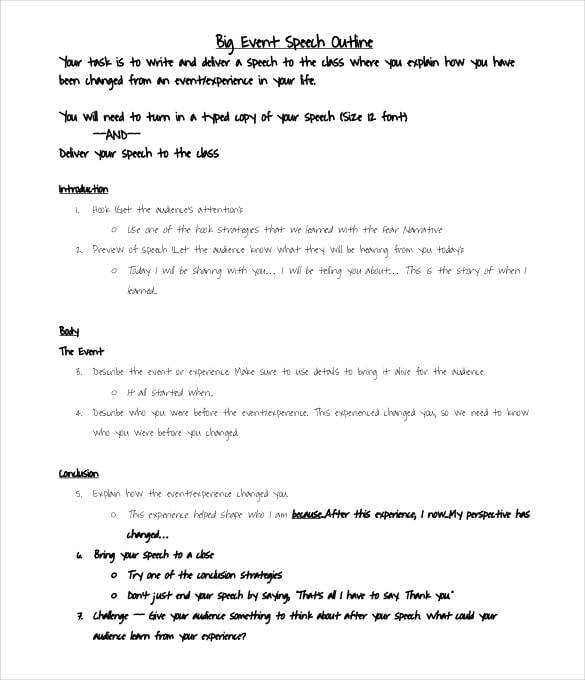
International Law Conference Speech Outline
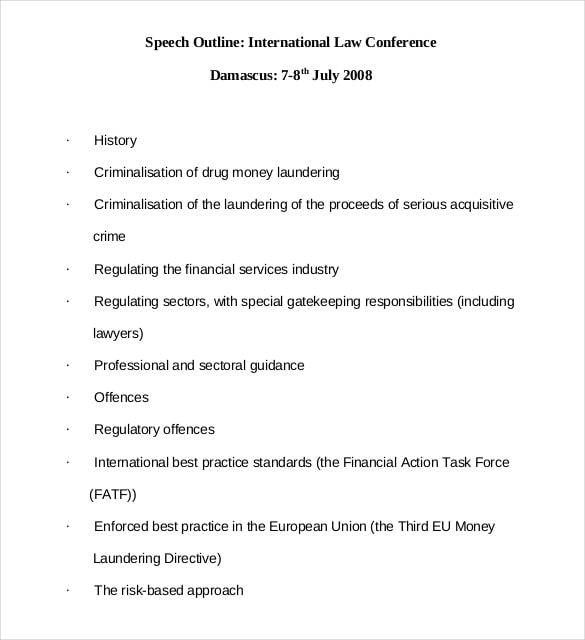
How to Write a Speech Outline?
- Start the outline with the greeting that you intend to make before the speech.
- Open you speech with something that grabs the attention of the audience.
- Describe this briefly in the outline.
- Next add the reason as to why the audience should be interested in the speech.
- Then go on to present your speech.
- Add in a preview of all the points that you would be using during the course of the speech.
- Include all the important arguments that you wish to use.
- Conclude with a brief summary of the speech.
What should a Speech Outline Include?
- Opening statement or greeting
- Introduction
- An attention-grabbing statement
- Reason for hearing the speech
- Objective of the speech
- Arguments to be given
- Closing statement
What is the Specific Purpose of a Speech Outline?
- It helps you to feel more confident as you have a clear idea of what and how to speak.
- With a speech outline in tow, you do not have to refer to your notes time and again.
- You can list interesting anecdotes in the outline which would help you to keep the audience interested and engaged. You can also see Blank outline templates .
- If you have a speech outline you can rest assured that you do not waver from the topic at any time.
- Every point should be clear and precise.
- Do not repeat your speech in the outline. Rather try to summarize it.
- Make sure that the points are not too long as this would make it difficult to find the relevant content quickly.
- Break the contents into bullet points and subsections to make it easier for you to search the required details.
- Do not go overboard when it comes to including attention seeking lines.
More in Outline Templates
Whatsapp speech bubble vector, ramadan: reflections on spiritual growth and self-discipline speech template, closing ceremony speech template for event, closing ceremony speech, short informative speech, informative speech template for students, student council president speech, short student council speeches, self introduction speech for students, self introduction speech.
- 10+ Training Outline Templates – PDF, Word, Apple Pages
- 24+ Autobiography Outline Templates & Samples – DOC, PDF
- 10+ Project Proposal Outline in Google Docs | MS Word | Pages | Editable PDF | InDesign | Photoshop | Publisher | PDF
- 12+ Literature Review Outline Templates – PDF, DOC
- 15+ Thesis Outline Templates – Sample, Example
- 11+ Outline Report Templates in Google Docs | Word | Pages | PDF
- 10+ Production Outline Templates
- 12+ Project Outline Templates in Google Docs | Word | Pages | PDF | XLS
- 15+ Meeting Outline Templates in PDF | DOC
- 8+ Project Proposal Outline Templates
- 12+ Outline Templates in Apple Pages
- 10+ Outline Templates in Word
- 10+ Outline Templates
- 15+ Topic Proposal Outline Templates – PDF, Word
- 12+ Research Project Proposal Outline Templates – PDF, Word, Pages
File Formats
Word templates, google docs templates, excel templates, powerpoint templates, google sheets templates, google slides templates, pdf templates, publisher templates, psd templates, indesign templates, illustrator templates, pages templates, keynote templates, numbers templates, outlook templates.
- Games, topic printables & more
- The 4 main speech types
- Example speeches
- Commemorative
- Declamation
- Demonstration
- Informative
- Introduction
- Student Council
- Speech topics
- Poems to read aloud
- How to write a speech
- Using props/visual aids
- Acute anxiety help
- Breathing exercises
- Letting go - free e-course
- Using self-hypnosis
- Delivery overview
- 4 modes of delivery
- How to make cue cards
- How to read a speech
- 9 vocal aspects
- Vocal variety
- Diction/articulation
- Pronunciation
- Speaking rate
- How to use pauses
- Eye contact
- Body language
- Voice image
- Voice health
- Public speaking activities and games
- About me/contact
- Understanding demonstration speeches
Demonstration speech sample outline
How to leave an effective voice mail message.
By: Susan Dugdale | Last modified: 02-12-2023
The demonstration speech sample outline below follows the logical step-by-step process that is essential for any "how to" type of speech. E.g., how to fix a flat tire, how to play a board game, how to make a friendship bracelet, how to put together a kick starter campaign...
An outline is a great tool: one of the very best ways to prepare an effective demonstration speech. It allows you to map out an entire speech about a particular process in easy steps.
Quite simply, you need one to ensure you're on track in front of an audience, that your series of main points are in the right order, that your use of visual aids is smooth...
The specific task the speech I've prepared to show you how it works covers what's involved in leaving an effective voice mail message: one that doesn't get deleted immediately!
You'll see that each part of the outline builds on what went before it, leading the audience from start to finish through the number of steps needed to put a good voice message together.
Get a printable blank demonstration speech outline

The outline template I've used is available for your use too. I've made a printable blank version of it for you download.
You'll find the link at the foot of the page, along with a video of the speech.
The voice you'll hear, when you play that, is me, Susan. (If you're on a desktop, see the photo in the righthand column!) And my accent is New Zealand.
About this demonstration speech example
As I was preparing this 'how to' I had in my mind young adult audience members: high school, or college students.
The speech covers one of a number of vital soft skills * needed to open doors to work opportunities, or to make connections with people who can help them to get where they want to go. Leaving an effective voice mail message is often the very first step on that journey.
* For more soft skills demonstration speech topics .
Which bits of this speech outline are said aloud?
Everything in bold eg. Title of speech , General purpose ... is not said aloud. These are the titles or labels of the various parts of the speech outline template.
Anything in italics eg. Gathering your information your information ... is not said aloud.
The speech itself begins with these sentences:
'How many important voice mail messages have you bumbled through after the beep? Does recalling them make you feel a little uncomfortable?'
Title of speech: How to leave an effective voice mail message after the beep
General purpose: to demonstrate
Specific purpose: to demonstrate (teach) how to leave a good voice mail message
Central idea (thesis statement): save yourself and the person you’re leaving the message for the frustration caused by: you not getting the result you wanted and the person you left the message for not understanding what you wanted.
Introduction Attention grabber:
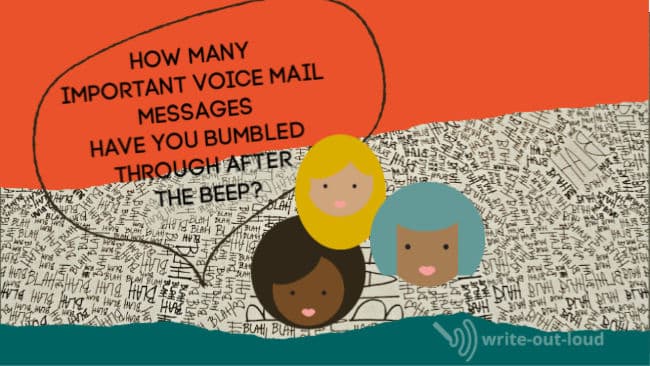
How many important voice mail messages have you bumbled through after the beep? Does recalling them make you feel a little uncomfortable?
Credibility builders: Yep, me too. I’ve blundered. Mumbled and muttered. If it were possible, I would have gladly saved the person I was calling the hassle of deleting those messages myself. Before they were heard.
However no more. I’ve learned how to leave an effective voice mail message. One expressing politely, clearly and succinctly all that was needed for whoever listened to it to understand exactly what I was calling about. One that that wouldn’t make me cringe if I heard it.
Preview: Today I’m going to share how to do that with you.
No more embarrassment. No more tongue-tied after the beep blues. This is a skill easily gained, and one that will open doors for you again, again and again.
Transition: Are you ready? Let’s go.
Body of speech Step one:
A lot of the time we already know as we’re entering the numbers for whomever we’re calling: our plumber, the manager of our local community center, or to request information about an advertised job vacancy that the likelihood of our call going through to voice mail is reasonably high.
So here’s the first step toward crafting a good message. Gather up everything we want to say before entering the phone numbers of the person we want to talk to. This will ensure we give ourselves the best chance possible of avoiding the dreaded ‘delete’.
(Show visual aid : Who, what, why, when, where and how chart.)

Sub-step one: We need to cover off who, what, why, when, where and how. Depending on what we want to say, some of them, more than once.
Who we are. Eg. Joe Smith
Where from. Eg. Forest Farm
How we can be contacted. Eg. My number is 021 445 8834
Who we want to talk to. Eg. Sam White. (This step is needed if we’ve not directly gone through to the voice mail of the person we want to speak to.)
What we’re calling about: Eg. the planned community tree planting day
Why we’re calling: Eg. to confirm the numbers of trees required
When we need an answer: Eg. by next Tuesday
It’s fairly straightforward, isn’t it? Pure logic, that you would think before you speak and have your message organised. Alas, some of us don’t. Then in the nano-second following the beep suffer a logic by-pass and side step into voice-mail hell.
Step two: Reviewing the worst types of voicemail messages It’s worth reviewing what types of voice mails make themselves candidates for instant dismissal. Here’s a few of the worst in all their ghastly glory from the ‘what not to do’ department. Consider them aversion therapy!
Sub-step one: Examples The longest ever. Squeezing in every little detail possible is unnecessary. It is quite literally, too much.

The gabbler. The person who talks so quickly that it’s impossible to make out what they’re saying.
The anonymous. The person who presumes you’ll know who is speaking, and you’ll also know how to contact them, so they don’t tell you.
The ummer and ahhher. This person leaves a message made up of 75% filler words and 25% substance - making it hard to summon the enthusiasm to dig through the dross for the gold.
Transition Let’s leave gobble-de-gook voice mail behind us.
Let’s start right now by preparing a message that ticks all the boxes. It will let the person you’ve called know who is calling, your number so that they can return the call, what you are calling about clearly, and briefly, and what you would like, or want, the person you’ve called to do. It’s both friendly and professional.
Sub-step one To do this we’ll return to who, what, where, when, why and how
(Display chart)
Sub-step two To demonstrate we’ll use the example mentioned earlier.
We’ll pretend we’re Joe Smith from Forest Farm, calling Sam White, the manager of the local Community Outreach Center, about the planned tree planting day coming up soon. Joe has previously agreed to supply the trees and now needs to know which varieties, and how many of each them are wanted. He would like an answer by next Tuesday.
Sub-step 3 Now let’s prepare the message.
Hi Sam Joe Smith here from Forest Farm 021 445 8834 I’m calling to finalize the varieties and numbers of trees required for our tree planting day. To get them ready we need to know by next Tuesday. Thanks. Looking forward to hearing from you.
Sub-step 4 Now let’s check it.
Does it cover everything it should?
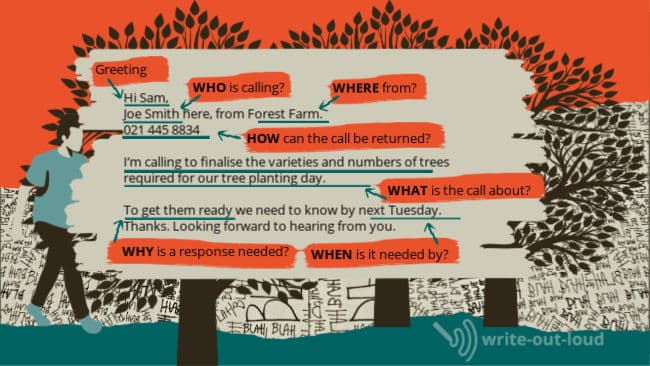
A greeting? Yes.
Say who it’s from? Yes. Joe Smith (That’s ‘Who’)
Provide the person called with context? Yes. Forest Farm. (That’s ‘Where’.)
Give contact details? Yes. (That’s ‘How’ covered - how to return the call.)
Give a brief, clear reason for leaving the message. Yes. (The ‘What’ is the varieties and number of trees needed.)
Give a reason ‘Why’? Yes. To get them ready in time we need that information soon.
Give a time frame? Yes. (That’s ‘When’ sorted.)
Transition OK - so this is the type of voice mail message we’d like to leave, and receive. Therefore the next major step is practice.
Rinse and repeat! The only way to master leaving quality voice mail messages is to practice. A lot.
Sub-step one Use the recording function on your phone to record yourself leaving messages of varying types. For instance: asking for an appointment or reminding someone they were going to get back to you a few days ago and haven’t.
Sub-step two When you play them back listen carefully.
- Are you speaking clearly?
- Have you avoided filler words? (Um, ah, like, yeah ...)
- Have you carefully and slowly given your number ?
- Is the tone of your voice friendly? (Smiling while you talk will make it sound that way.)
- Is your message brief and does it cover everything it needs to? (That’s the who, what, where, why, when and how.)
- Are the words you’ve chosen to use appropriate? (The vocabulary we use with a close friend is often very different from the words we’d choose to talk with a prospective employer. Getting it wrong could have consequences!)
Sub-step three
If you’ve answered ‘no’ to most of these questions. You already know what you need to do. More practice. Like any new skill it takes a while to become second nature – a habit. Keep at it.
Yes, to some aspects and no, to others? Keep practicing, focusing on what you need to master.
Yes, to everything? Congratulations. You’re ready to go.
Transition You see? It’s not that hard.

Conclusion The voice mail messages we leave represent us. They’re personal ambassadors – making our way forward easier, or harder. A well crafted message is much more likely to be heard in its entirety and acted on. Pause before you call. Think. Structure. Then ring and speak with confidence!
Listen to this demonstration speech example
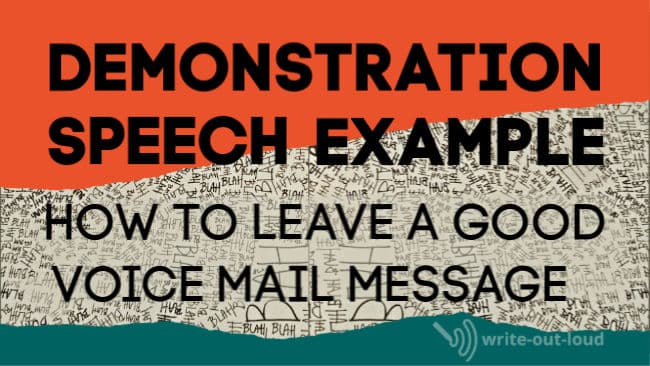
I've recorded it and added some slides to make it a 'show and tell'.
Either click this link: How to leave an effective voice mail message , or on the image above to play it.
Feel free to share, comment, like, or dislike it, as you see fit!
Download the blank speech outline template

This template is a pdf. To open, read and print it you must have a pdf reader installed on your computer. If needed here is a link to download the free Adobe Acrobat Reader DC software you require.
If you haven't much time to sort out the best topic for your target audience, to find interesting facts and additional information to support it, to the think through the series of steps required and prepare for a q&a session at the conclusion of your presentation, completing an outline is great way to lessen your stress levels!
More resources for demonstrative speeches
100s of topics for demonstration speeches .

Here's a collection of 290+ demonstration speech topics , including that evergreen favorite: 'how to choose a pet'.
And here's another selection of good examples of demonstrative speech topics arranged by theme: business, entertainment, frugal living, caring, public speaking.
The previously mentioned soft skills 'how-to' speech ideas are here: 50 speech topics focusing on 'soft skills ' .
Plus, there's 100 short 3-10 minute demonstration speech ideas , 188 funny how to speech topics and guidelines on how to prepare the best demonstration speech you can.
PS. For more on voice mail messages
Check these excellent links:
- T he ten worst types of voice mails - an evergreen article published on the Grasshopper blog. (Thank you!)
- How to leave professional voice mail messages - published by Energy Resourcing
- How to leave a professional voice mail message - published by 'the balance small business'.
speaking out loud
Subscribe for FREE weekly alerts about what's new For more see speaking out loud

Top 10 popular pages
- Welcome speech
- Demonstration speech topics
- Impromptu speech topic cards
- Thank you quotes
- Impromptu public speaking topics
- Farewell speeches
- Phrases for welcome speeches
- Student council speeches
- Free sample eulogies
From fear to fun in 28 ways
A complete one stop resource to scuttle fear in the best of all possible ways - with laughter.

Useful pages
- Search this site
- About me & Contact
- Blogging Aloud
- Free e-course
- Privacy policy
©Copyright 2006-24 www.write-out-loud.com
Designed and built by Clickstream Designs
- Study Guides
- Homework Questions
COM 213 Speech Outline Template (1)
- Communications
OpenAI debuts voice cloning tool, but deems it too risky for public release
ChatGPT creator says Voice Engine can replicate a person’s voice based on a 15-second audio sample.

OpenAI has unveiled a tool for cloning people’s voices but is holding back on its public release due to concerns about possible misuse in a key election year.
Voice Engine can replicate a person’s voice based on a 15-second audio sample, according to an OpenAI blog post demonstrating the tool.
Keep reading
Tens of thousands take part in antigovernment protests in israel, israeli military says it killed hezbollah commander, turkey’s opposition claims victory in major cities, the high cost of being a whistleblower in china.
But the ChatGPT creator is “taking a cautious and informed approach” to the technology and hopes to start a dialogue on “the responsible deployment of synthetic voices”, the company said in the blog post published on Friday.
“We recognize that generating speech that resembles people’s voices has serious risks, which are especially top of mind in an election year,” the San Francisco-based start-up said.
“We are engaging with U.S. and international partners from across government, media, entertainment, education, civil society and beyond to ensure we are incorporating their feedback as we build.”
We're sharing our learnings from a small-scale preview of Voice Engine, a model which uses text input and a single 15-second audio sample to generate natural-sounding speech that closely resembles the original speaker. https://t.co/yLsfGaVtrZ — OpenAI (@OpenAI) March 29, 2024
OpenAI said it would make “a more informed decision” about deploying the technology at scale based on testing and public debate.
The company added that it believes the technology should only be rolled out with measures that ensure the “original speaker is knowingly adding their voice to the service” and prevent the “creation of voices that are too similar to prominent figures.”
The misuse of AI has emerged as a major concern ahead of elections this year in countries representing about half the world’s population.
Voters in more than 80 countries, including Mexico, South Africa and the United States are going to the polls in 2024 , which has been dubbed the biggest election year in history.
The influence of AI on voters has already come under scrutiny in several elections.
Pakistan’s jailed former Prime Minister Imran Khan used AI-generated speeches to appeal to supporters in the run-up to the country’s parliamentary elections in February.
In January, a political operative for the long-shot US presidential candidate Dean Phillips put out a robocall impersonating US President Joe Biden that urged voters not to cast their ballots in New Hampshire’s Democratic Party primary.
OpenAI said it had implemented several safety measures for its partners testing Voice Engine, “including watermarking to trace the origin of any audio generated by Voice Engine, as well as proactive monitoring of how it’s being used”.

COMMENTS
When outlining your speech, make sure to decide how much time you'd like to give each of your main points. You might even consider setting specific timers during rehearsals to get a real feel for each part's duration. Generally speaking, you should allot a fairly equal amount of time for each to keep things balanced.
1. choosing a topic, 2. audience analysis, 3. choosing the best organizational pattern to fit your speech purpose, 4. what to put in each part of your speech: introduction, body and conclusion. a printable speech outline template to download. links to 2 completed examples of speech outlines (a demonstration and a persuasive speech.
Before you begin writing your outline, you should take a step back and think about your speech as a whole. First, think about the 3 keystones for your presentation or speech, i.e. the audience, your subject matter and of course, you, as the speaker. Then, write a few notes down about each keystone and how they relate with each other.
The outline for a public speech, according to COMM 101 online textbook The Public Speaking Project, p.p. 8-9. Use these samples to help prepare your speech outlines and bibliographies: Sample Speech Preparation Outline
1. State your first point. The outline of the body of your speech will begin with the first point you intend to make in your speech. Write out a smooth transition from your introduction into the body of your speech. Your first point will be a top-level entry on your outline, typically noted by a Roman numeral.
Here's Martha's Finished Outline as an example. Speech length: 15 minutes with extra time for a 'Question and Answer' session at the end of the presentation. Speech title: How to win a future for your family when the kids need feeding, and the bills want paying. Introduction (2.5 minutes): Thanks for coming today … Summer heat, we'd all ...
To create a working outline, you will need: A speech topic. An idea for the "hook" in your introduction. A thesis statement. 3-5 main points (each one should make a primary claim that you support with references) A conclusion. Each of your main points will also have sub-points, but we'll get to those in a later step.
Here is the basic speech outline, including an introduction, body, and conclusion. For planning purposes, each section is explained to understand the textual arrangements best. Examples are given later in the text. Introduction Every basic speech outline includes an introduction. This is your speech opening, and it needs to be robust and ...
Lucidchart's template shows you how to write a speech outline that eloquently communicates your innovative message and engages your audience. Use the Vivid Speech Outline custom shapes to quickly build your message statement and chunk structure pages. Simply drag and drop the custom shapes from the shape repository (or any shape in the ...
That's why we've put together this complete, step-by-step guide on how to write an informative speech outline. From selecting a topic to transitioning during your speech, this guide will have you well on your way to writing a compelling informative speech outline. So grab your pen and paper, put on your thinking cap, and let's get started!
As you can see, knowing that you want to inform your audience is just a small part of your speech. To make your speech as effective as possible, write with the right type of speech in mind. 1. Choose Your Topic. Before starting your informative speech outline example, you need to know what you're writing about.
Step 1: open the speech with a greeting and introduction. As a matter of courtesy, it is a good thing to open the speech with a greeting. Follow this by introducing yourself. Take time also to thank those who have attended that event as well as its organizers. Lastly, thank the person who asked you to arise and speak.
Tell them (Body of your speech - the main ideas plus examples) Tell them what you told them (The ending) TEST before presenting. Read aloud several times to check the flow of material, the suitability of language and the timing. Return to top. A step by step guide for writing a great speech.
2. Body. The body section allows you to provide details of the particular topic of your speech. Section 1. Write the main idea of the section. Provide supporting details, examples, and evidence to support the idea. Smoothly transition to the next main point of your speech. Section 2.
Ideas for your persuasive speech outline 1. Structure of your persuasive speech. The opening and closing of speech are the most important. Consider these carefully when thinking about your persuasive speech outline. A strong opening ensures you have the audience's attention from the start and gives them a positive first impression of you.
Reason 3 ( Provide one reason as to why listeners should act or think the way your thesis suggests.) Example 1 - Support for the reason given above. Example 2 - Support for the reason given above. The most important part of a persuasive speech is the conclusion, second to the introduction and thesis statement.
How to Speech: 4 Key steps to doing what you are talking about. Example: Step One: Clean the chicken of any unwanted feathers and giblets. Step Two: Spice the chicken and add stuffings. Step Three: Set oven to 425 degrees Fahrenheit. Step Four: Place chicken in the oven and cook for an hour.
Informative speech outline is readily available on our main website. If you are looking for informative speech outline template of any type, you can download it from our main website and use for your effective informative speech. We hope our templates help you in giving the best speech. Download 22 KB. #26.
It lets the audience know that the speech is about to end. Like the introduction, the conclusion can be broken into two parts: the review and the final statement. A. Review: During the first part of the conclusion, the speaker restates the topic of the speech and each main point. B. Final Statement: The speech ends with a strong final statement.
Advertisements. A basic speech outline is very simple and goes a little something like this. Greeting: Everything we do in communication starts with a greeting of some kind. New business and acquaintance introductions being with a greeting; our mornings begin with a greeting; telephone calls; office memos; even shopping begins with a greeting.
29+ Speech Outline Templates - PDF, DOC. When you download a free speech outline template sample, you will find that this premium template helps you to clarify what you wish to say to the audience as well as organize all the print material you have in an easy and reliable manner. The Outline Template decreases the burden of having to draw up ...
The outline template I've used is available for your use too. I've made a printable blank version of it for you download. You'll find the link at the foot of the page, along with a video of the speech. The voice you'll hear, when you play that, is me, Susan. (If you're on a desktop, see the photo in the righthand column!)
COM 213 Speech Outline Template Use this template to plan the organization and content of your speech. Replace the bracketed text with your responses. You may use bullet points unless otherwise noted. Planning Speech Topic: The importance of special education and the inclusiveness of it in schools. General Purpose Statement: This is an informative presentation that could also be persuasive.
We're sharing our learnings from a small-scale preview of Voice Engine, a model which uses text input and a single 15-second audio sample to generate natural-sounding speech that closely resembles ...